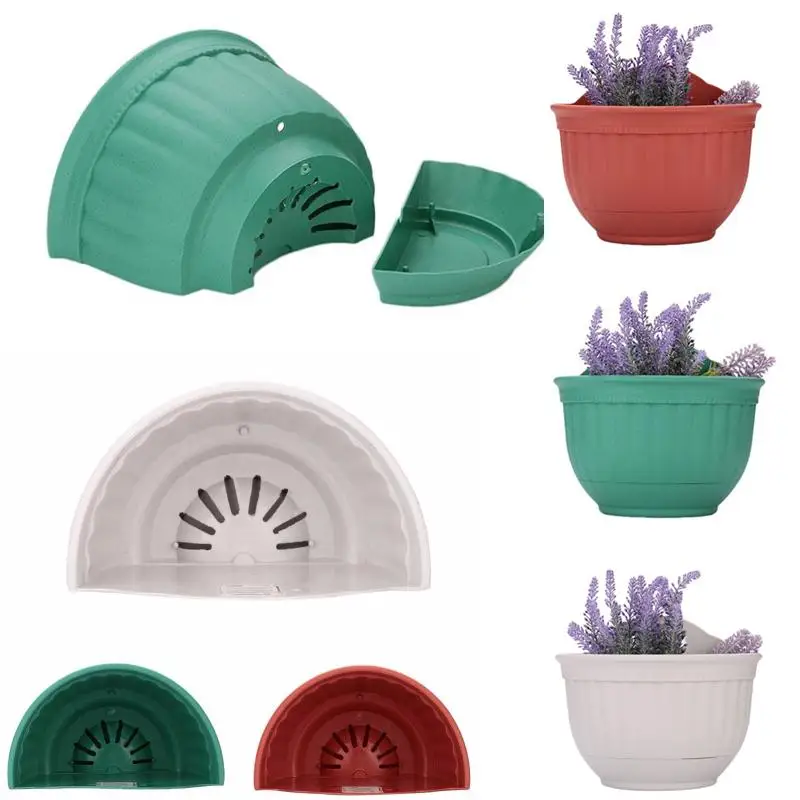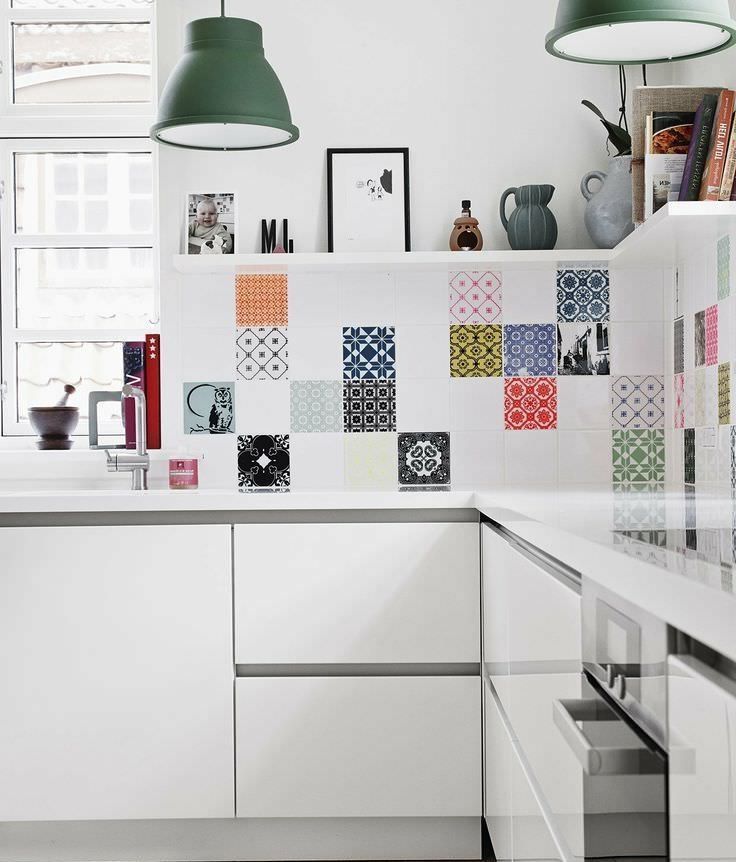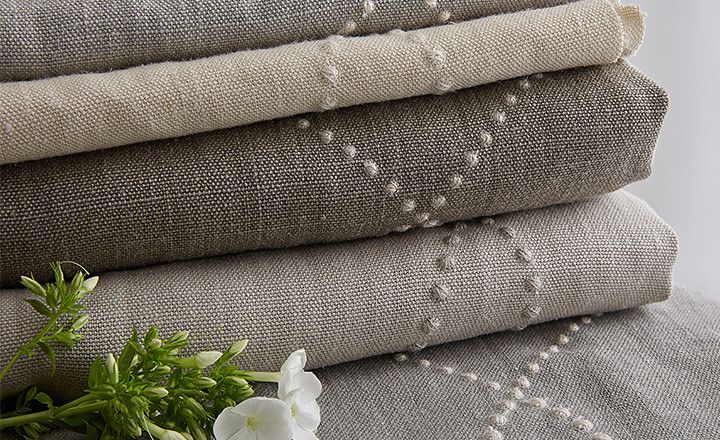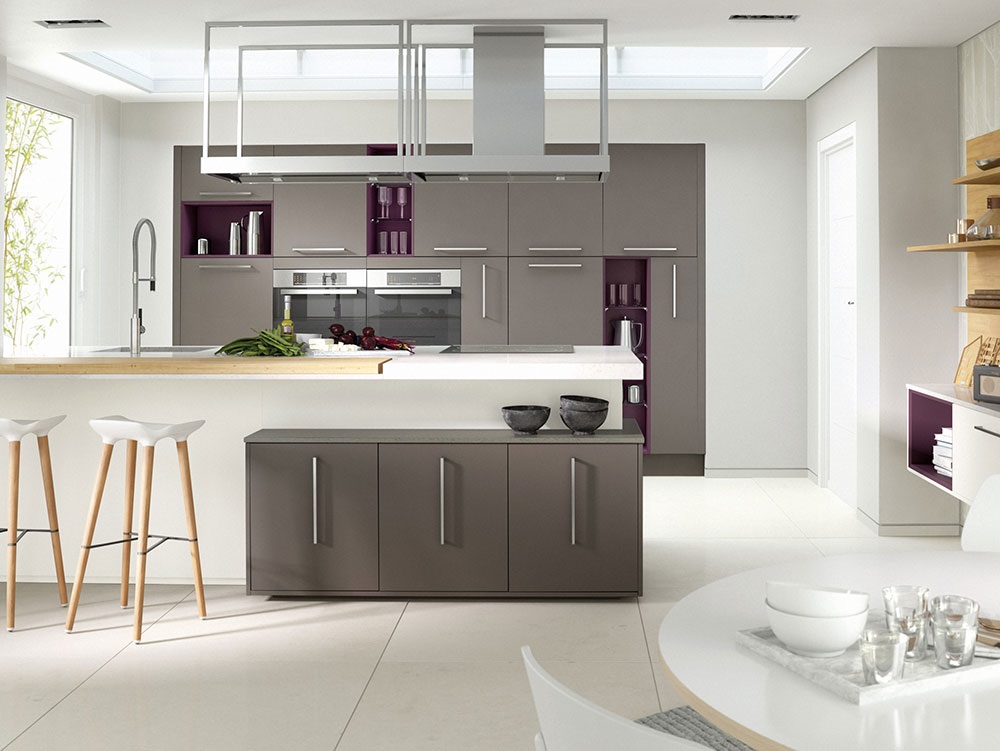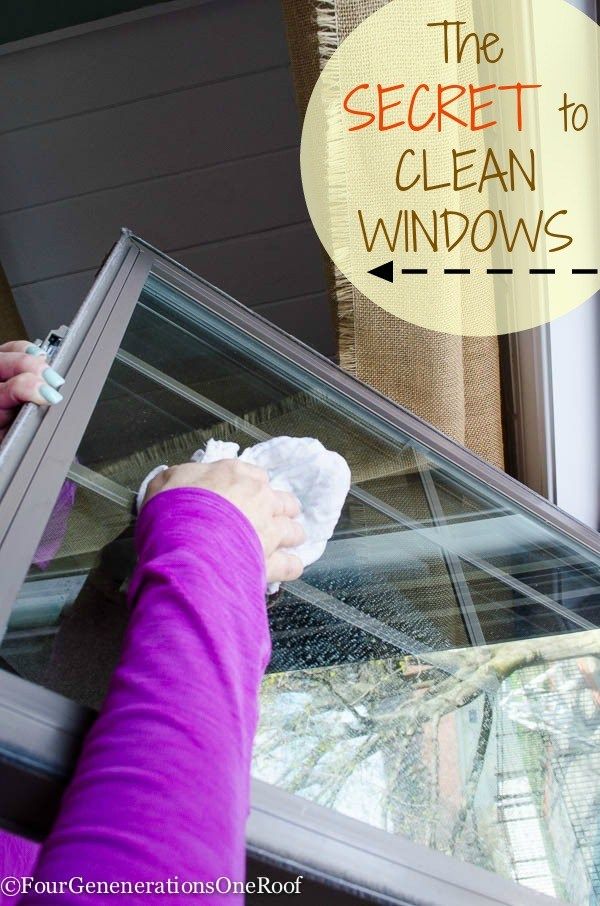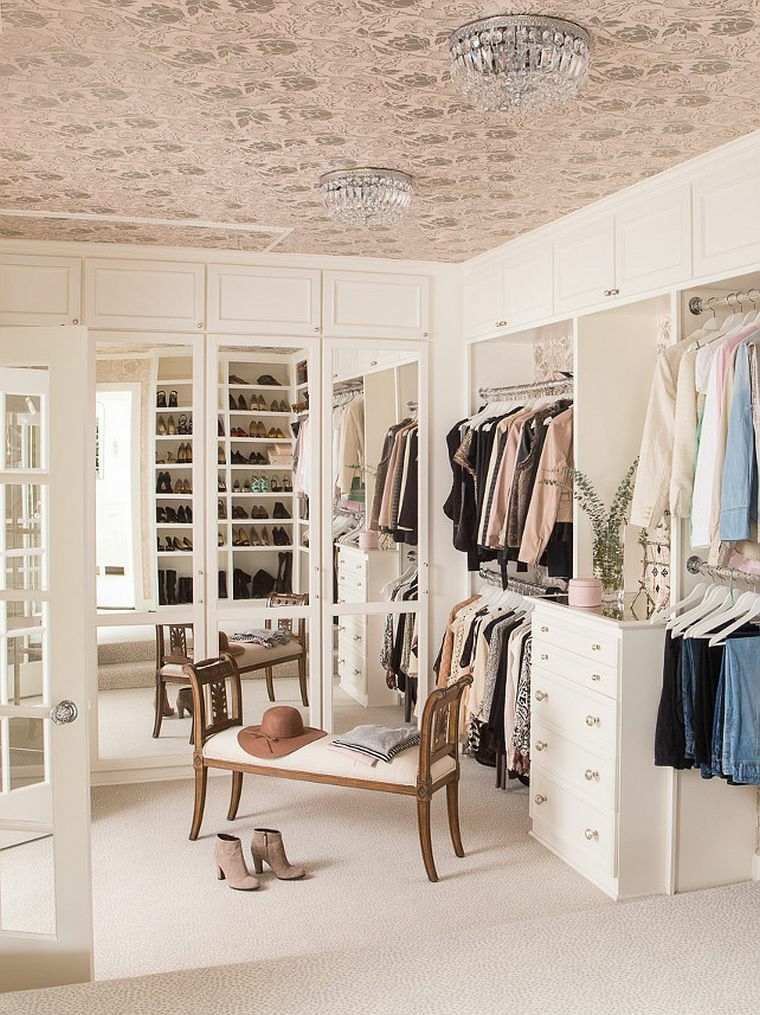Ideas for sloped backyard
15 design tips for a terraced garden |
There are endless possibilities when it comes to sloped backyard ideas – and rather than a challenge, sloping gardens can open up lots of design and planting possibilities to create unique spaces.
With a little creativity, strategic planning and the right backyard ideas, a sloped backyard can have a lot to offer.
You can create a terraced garden of distinct areas, with spaces for entertaining, relaxing, playing and dining, offering different views for an ever changing perspective of your backyard.
Sloped backyard ideas
Understanding the site of a sloped backyard is key, and ‘terracing can create a usable garden where before only a slope existed,’ explains landscape designer Lorenzo Soprani Volpini of LSV Gardens .
A terraced garden can offer creative layout and planting options and there are a number of elements to consider in how to design a sloping garden.
‘Sloped gardens can often be viewed as “problem sites” but, in fact, can be ideal for formal terraced garden design. Formal Roman or Mediterranean garden characteristics can be reflected and recreated within a formal terraced garden setting – emulating geometric symmetry reproduced within the contemporary gardens of today,’ explains garden designer Karen McClure .
Whether you are looking for inspiration for the ultimate entertaining space or need backyard ideas on a budget, these sloping backyard ideas will take your space to new heights.
1. Consider the view
(Image credit: Sara Jane Rothwell / London Garden Designer)
When deciding on sloped backyard ideas, start by considering the main view of the garden from the house.
‘If your garden falls away from the house or patio, try to avoid large drops by opting for several shallower terraces or stepped beds, so you don’t need to install railings that can interrupt the view,’ explains designer Marlene Lento .
‘For very steep gardens, mix sloping, more naturalistic planting design, with level portions to minimize tall retaining walls or too many steps.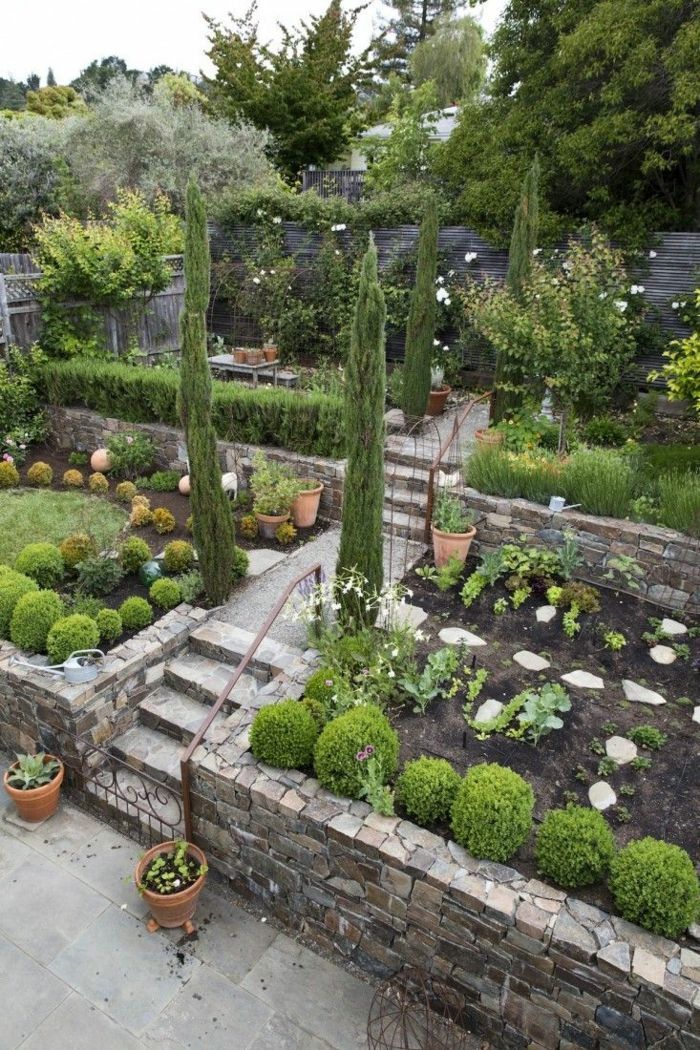 This is especially important if your garden slopes up from the house and you will be looking onto the face of those retaining features,’ she adds.
This is especially important if your garden slopes up from the house and you will be looking onto the face of those retaining features,’ she adds.
But do also 'consider views into neighboring gardens and privacy for all involved,’ adds Karen McClure.
In the above design by Sara Jane Rothwell the backyard that slopes up from the house was designed for a gentle meandering journey up via wide steps and discreet terracing, to avoid too many traditional steps and handrails.
2. Use natural materials for terrace walls
(Image credit: Michelle Brandon Garden Design)
To create a terraced garden, there are many choices of materials for retaining walls. Walls can be retained with natural stone or brick; timbers or sleeper walls create a rustic style, and for a country garden aesthetic, use natural, local materials wherever possible. The walls should tie in with the design of your other sloped backyard ideas.
‘Look to match or tie in with the house and existing structures in and around the garden.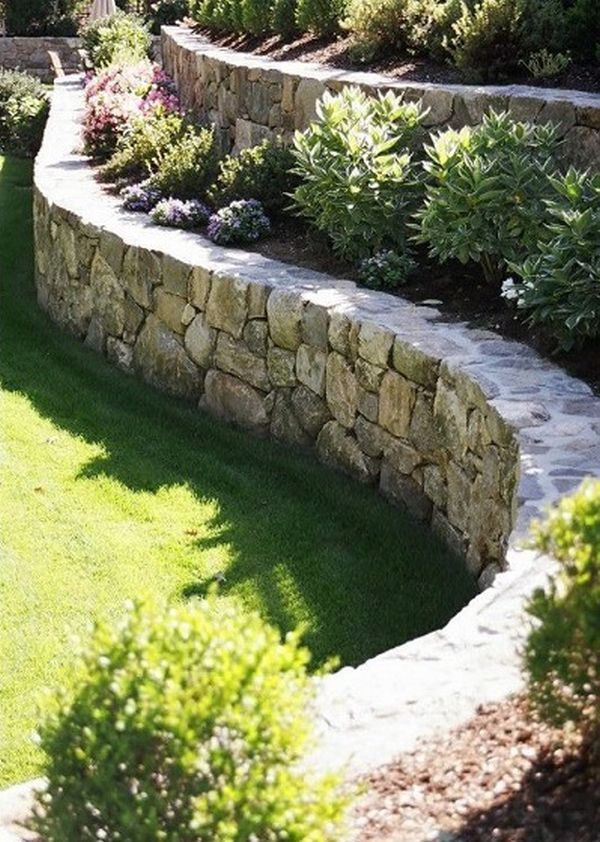 Using materials that are sympathetic to the local vernacular will sit much more comfortably in the wider landscape,’ says designer Ed Oddy .
Using materials that are sympathetic to the local vernacular will sit much more comfortably in the wider landscape,’ says designer Ed Oddy .
The above terraced garden design by Michelle Brandon uses Knapp flint and sandstone walls, which feature regularly in the village where this garden resides.
3. Opt for a contemporary finish
(Image credit: Marlene Lento Design)
For a more tailored, contemporary look, cladding materials for walls, such as Corten steel and crisp render, provide a sleek finish and easy curves.
'Do, however, consider the upkeep and how these materials will weather and age in the climate. I like to work with materials that enhance over time, and embrace the beauty of the ageing process,’ says Ed Oddy.
‘In all cases include drainage behind the retaining wall in the form of a land drain that either discharges into existing drains or into a soakaway,’ advises Marlene Lento.
4. Recycle materials
(Image credit: Cube 1994 Garden Design)
Retaining walls can be an expensive option, so investigate ways to mitigate costs of high level changes, as well as the environmental impact.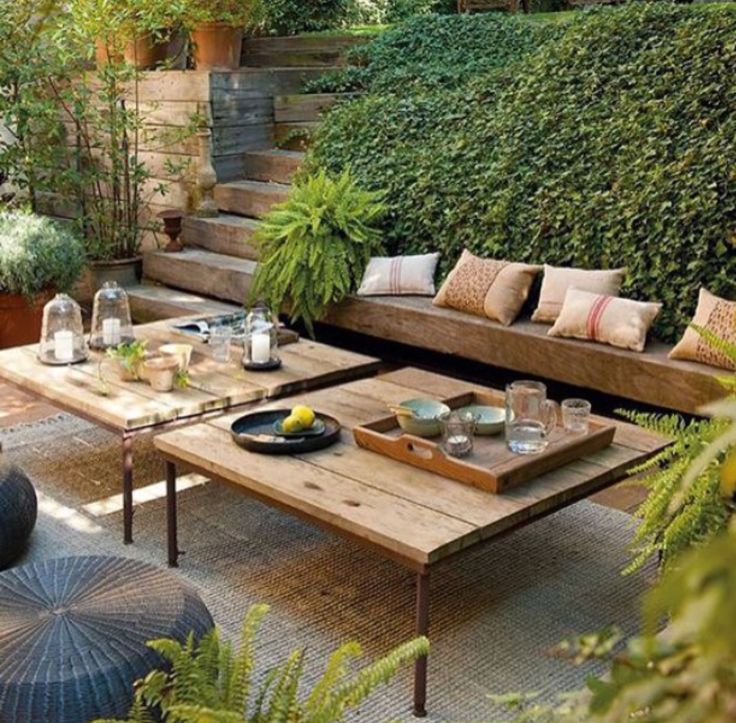
Reclaimed timber and sleepers are more cost effective for creating a terraced garden. Landscape designer Sean Butler of Cube 1994 also explains how they have used Gabion cages for terrace walls, recycling existing hardcore on site from the old patios and steps as a backfill within the gabions. These are then front filled with more attractive stone for an aesthetic appearance.
5. Soften steps with planting
(Image credit: Future / Mark Bolton)
You can soften the impact of the hard landscaping materials of steps and inevitable tall walls of terraced gardens, with planting and living wall ideas.
There are many options for vertical gardening ideas, either climbing up or trailing down the terraced levels.
‘Walls can create a great backdrop for small trees and architectural shrubs, and can be lit at night,’ says Samantha Brown.
There are many climbing plants that can scramble up and over terrace walls and levels, with some beautiful flowering climbers for seasonal color.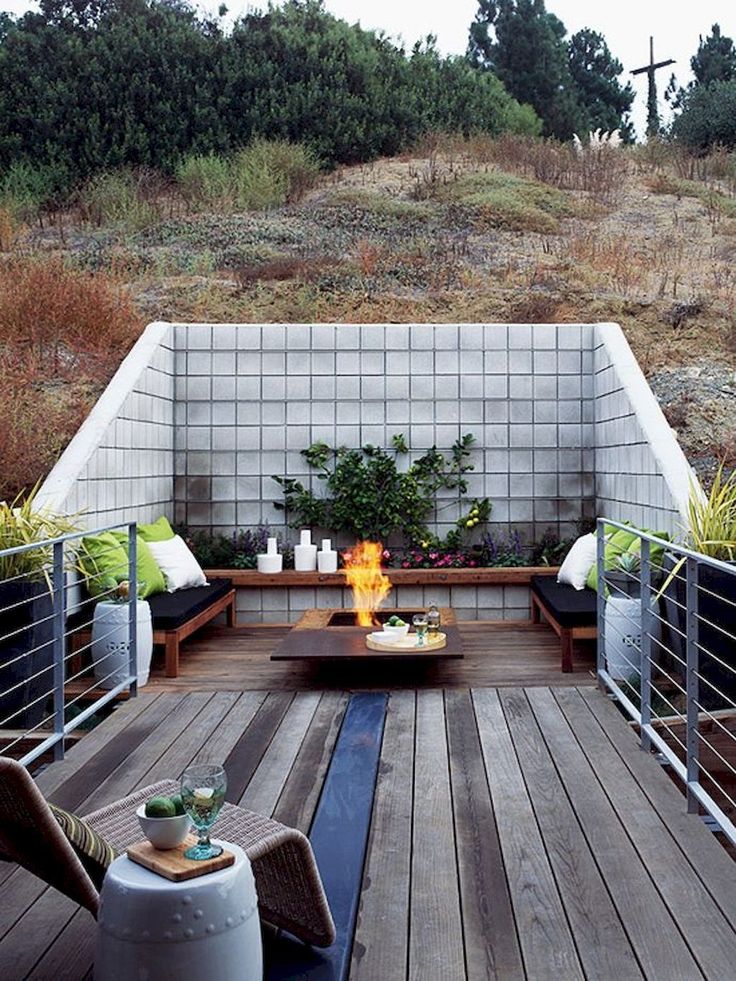
6. Layer planting
(Image credit: Annaick Guitteny)
Layering your plants and knowing their ultimate height for flower bed ideas for your sloped backyard is very important.
Consider the maintenance of planting in raised garden bed ideas as part of your sloped backyard ideas.
‘You want your plants, a mix of perennials and shrubs, to knit together quickly to block out homes for weeds and give the soil level an incline, that way your plants will grow facing forward and give you a better display,’ explains designer Michelle Brandon.
Garden designer Nigel Phillips suggests to add a layer of topsoil to terraced gardens to give plants a head start, and offers the following planting advice:
- Choose a limited plant palette with varying height, color and form and repeat down the slope.
- Select key year-round evergreen shrubs and ornamental grasses as anchor plants that also provide winter interest, such as Calamagrostis acutiflora ‘Karl Foerster’ and Cornus alba sibirica.
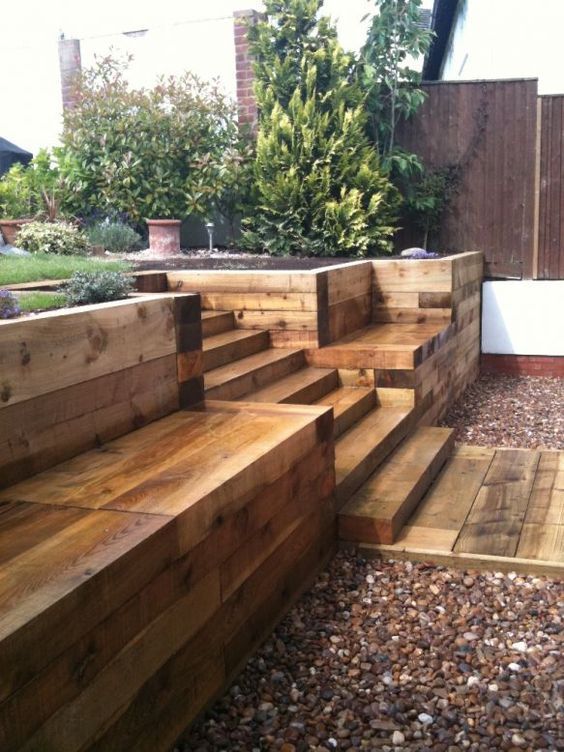
- Use soil-hugging groundcover plants, like the geranium family, adept at threading through plantings and tying them in to sloping sites.
- Place floriferous, ornamental plants along the garden path ideas, allowing them to tumble and flow, blurring the edges.
- Create a strong architectural backbone by weaving rivers or stands of taller ornamental grasses through long-flowering and clump forming perennials.
7. Ascend to greatness
(Image credit: Julie Toy)
As this option from multi-disciplinary firm RIOS proves, the simplest sloped backyard ideas and solutions can often be the most impactful.
Here, a minimalist pathway traverses a large bamboo forest, complete with 85 different plants. The garden is designed to be experienced during the dramatic sunset light, while the landscape bathes the hillside below the house in warmth and an energizing glow.
8. Level your land
(Image credit: Kendall Wilkinson Design)
San Francisco is known for its hilly landscape, so it’s no surprise that Bay Area-based designer Kendall Wilkinson has experience putting sloped backyard landscaping ideas into practice.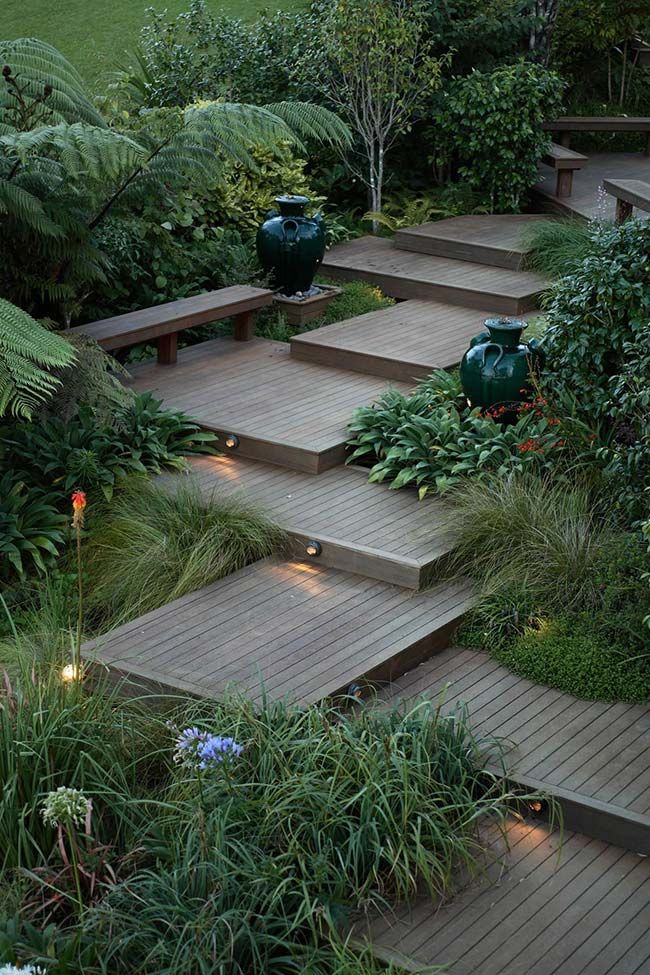 Although Wilkinson wanted to have a leveled yard for her clients, the stone wall and fireplace seen here accentuates the angled terrain.
Although Wilkinson wanted to have a leveled yard for her clients, the stone wall and fireplace seen here accentuates the angled terrain.
'You can see how significantly the yard is sloping behind the wall that provided the perfect foundation to add the fireplace and seating,' Wilkinson explains. 'Being placed on this side of the property makes this patio very quiet, serene, and relaxing.
'Paired with a metal pergola style roof, strategic lighting, and really comfortable matching sofas, wasted space becomes valued square footage.'
9. Go for a versatile vantage point
(Image credit: Vessi Ves)
Garden designer Georgia Lindsay used a combination of hard landscaping and clever small back yard ideas to transform a dangerously crumbling slope into a multi-purpose garden with various terraces.
The first terrace allows for a generous garden storage area for bikes and garden equipment beneath, while the lower part of the garden flows seamlessly from the house with hardwood decking to echo the internal flooring. A cozy seating zone and stylishly integrated outdoor lighting ideas complete the garden.
A cozy seating zone and stylishly integrated outdoor lighting ideas complete the garden.
'Sloping gardens can be great when it comes to lighting,' she shares. 'It's like an amphitheatre; you are able to enjoy your whole garden with one view.'
10. Fire up your sloping backyard
(Image credit: Camille Styles)
If you want to turn your sloped backyard into a liveable oasis, Camille Styles deftly bridged the gap between form and function. Here, the blogger built a handful of terraces, complete with seating areas and a fire pit.
'When we bought the property, there was crumbling stone terracing that had been built by the original owner of the property back in the 1950’s,' she wrote. 'It was covered by overgrown vines, but it always reminded us of old European estates and we imagined restoring it to its glory.'
11. Play away in a sloping space
(Image credit: Lyndon Douglas)
If you want to find sloped backyard ideas that are appealing to the entire family, consider adding a play area to your space as backyard ideas for kids.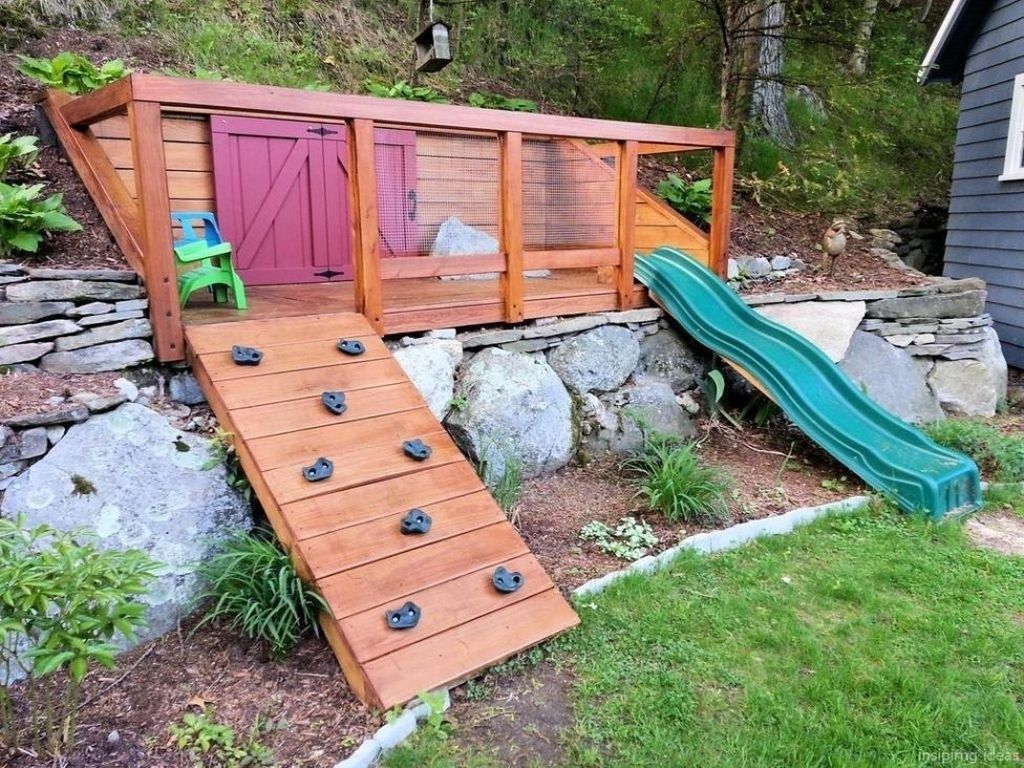 Fortunately, it’s possible to infuse some childish wonder without compromising your home’s style.
Fortunately, it’s possible to infuse some childish wonder without compromising your home’s style.
'Designed for a young family, the house features a sheltered lower courtyard space which provides greater privacy, and a triangular stepped landscape was proposed to manage the level change,' explains Mike Gibson of Eldridge London .
'The repetitive triangular planning allows for a variety of activities while maintaining a clear consistent identity. The triangular modules form planting beds, steps, trellises, sitting areas, and include a slide and sand pit play area.'
The result: A playful yet sophisticated environment.
12. Plan for a water wonderland
(Image credit: Cuckoo 4 Design)
Another way to bring some fun to your sloped backyard ideas is by adding a garden pool ideas.
Cuckoo 4 Design blogger Julia Konya refers to her sloped backyard as 'essentially a hill'.
By adding an above-ground pool, she is able to make the slope appear less severe, plus serve up some fun for the entire family.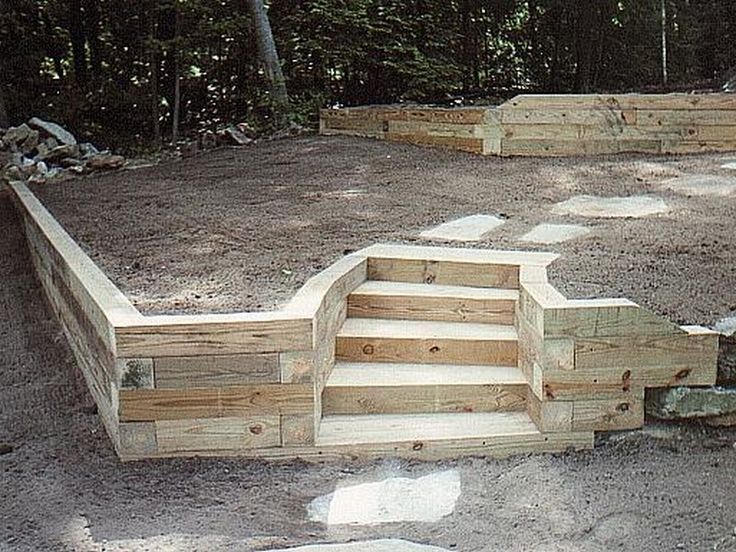 The wooden exterior takes inspiration from rock garden ideas and adds leafy greens to round out the look, turning this sloped backyard into a tropical oasis.
The wooden exterior takes inspiration from rock garden ideas and adds leafy greens to round out the look, turning this sloped backyard into a tropical oasis.
13. Plant fruit and vegetables on a slope
(Image credit: Elysian Landscapes)
For a sloped backyard that’s both practical and aesthetically pleasing, add a vegetable garden. Leslie Bennett of Pine House Edible Gardens decked out this space with wooden raised garden beds and pyramid-shaped trellises.
The raised garden beds follow the slope’s natural path, creating designated areas to grow everything from herbs and tomatoes to spicy chili peppers. Not only does this tip make the most of occupied space, but it will also resemble a lush, nutritious salad when in full bloom. Small vegetable garden ideas really can be incorporated anywhere, even on a slope, or if you'e more limited in planting space in raised beds, try vegetable garden container ideas.
14. Blur the boundaries with a stairway on a sloped space
(Image credit: Rachel Weil)
An outdoor staircase might be an easy way to optimize a sloped backyard, but it can often feel jarring when juxtaposed with the lush greenery.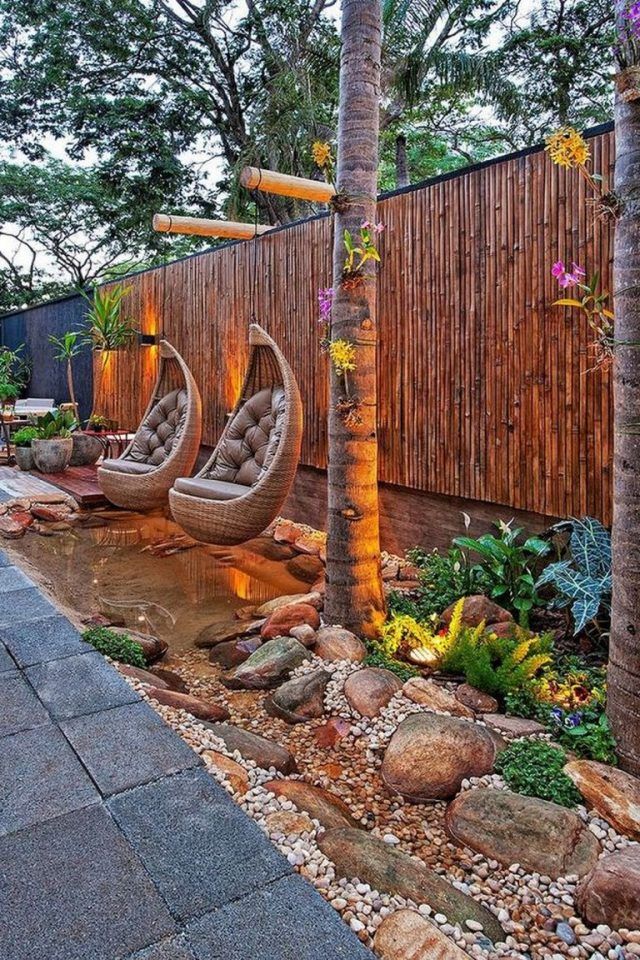
Los Angeles-based firm Elysian Landscapes blurred the lines of the hardscape by flanking each side of the stairs with a wild array of plants and grasses. This setup has an ethereal edge, thanks to its layers of textures and muted color palette.
(Image credit: Ian Kitson)
If you’re wondering how to landscape a backyard to make the hardscaping feel more pronounced, take a cue from Ian Kitson , who created this yard for an art collector.
'It looks over an estuary in Wales, which is tidal,' he explains. 'So twice a day, the water disappears and you get amazing patterns in the sand river bed: This is one of the clues the garden design takes.' The raised garden beds and curvy pathways highlight the sloped land, blurring the line between earth and water.
What to do with a backyard that is on a slope?
There are so many sloped backyard ideas and possibilities. Hard landscaping is key and requires careful planning in order to make effective use of the available space.
Slopes offer fantastic design opportunities and exciting new ways to experience and view a garden, whether it’s from up high, or down below. But steep slopes can also be both costly and awkward to manage, so they do require a bit more thought than usual.
When it comes to the wholesale redesign of a sloping garden, terracing is the obvious option. Unfortunately, creating a terraced garden is not a cheap one. Earth moving equipment is often necessary. So too are lengthy retaining walls, which are always expensive – particularly if they’re made from bricks and mortar.
If you need sloped backyard ideas on a budget, instead consider strategies that minimize major ground works. First and foremost, do you actually need to terrace the whole garden? It’s likely that one or two level plateaus built into the slope – for a bench or two perhaps – will create enough useable space and cost much less.
How do you make a sloped garden look good?
There are many ways to make a sloped garden look good, and far from having limited options, a sloping garden can offer a wealth of layout and planting possibilities – many of which you couldn't successfully achieve with a level plot.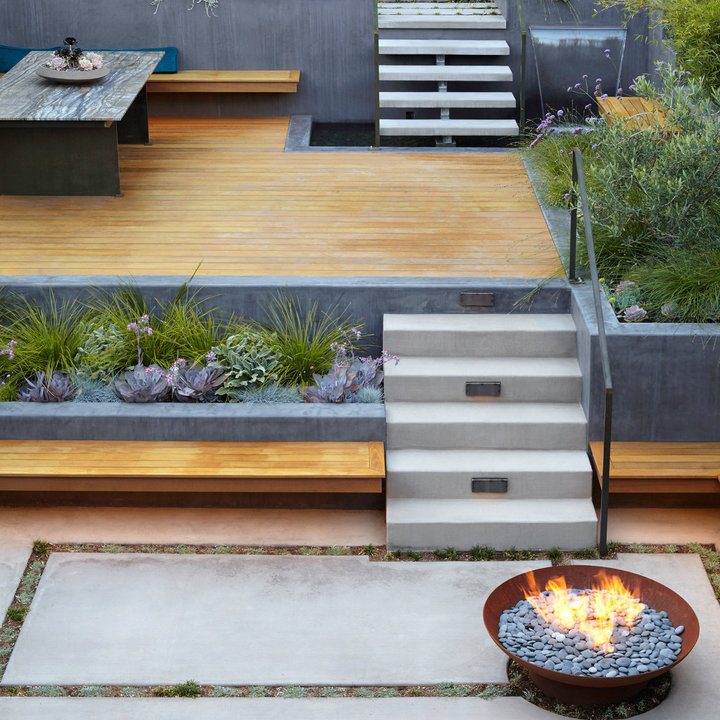
There are options to create different terraces and routes through the garden, creating garden rooms with different purposes and atmospheres.
‘Consider creating 'destinations’ and ‘rooms’ within a sloped backyard to provide a journey within the space – adding a purposeful place to make the most of sun-downers in that last hour of sunshine,’ says Karen McClure.
'Depending on whether you consider the terracing a feature of your terraced garden or a necessity, you can either enhance the outlines by neatly clipped planting to showcase them as a feature, or you can plant in front of them to hide or soften the level change,' advises Marlene Lento.
The use of cascading terraces and planting can provide a gentle transition from a house to the lower or upper garden levels.
Backyard Slope Landscaping Ideas - 10 Things To Do
Break Out in Tiers
1/11
Creating several tiers on a sloped property can help manage erosion and give you the opportunity to layer different plants and landscaping elements for a cohesive design. Whether you use railroad ties, stone pavers, or concrete to form the tiers, they will make a dramatic impact on the overall look of your property.
Whether you use railroad ties, stone pavers, or concrete to form the tiers, they will make a dramatic impact on the overall look of your property.
Related: 9 Clever Landscaping Hacks for Your Best-Ever Yard
istockphoto.com
Build Some Stairs
2/11
If you choose to let vegetation cover your sloping property in glorious abandon, impose a little order by building a set of stairs leading up to flatter ground. Whether you opt for a wooden staircase or concrete steps, this garden feature will blend into the landscape far better if it’s surrounded by plantings on either side.
Related: 12 Perfect Plants for Lining Your Pathway
istockphoto.com
Make a Natural Staircase
3/11
Use a natural material like stone to create a stepped pathway through your sloping property. A stone stairway will complement surrounding plantings and help anchor your landscaping design.
Related: 7 Thrifty Designs for a DIY Walkway
istockphoto.com
Design a Waterfall
4/11
If you’re ambitious, use the height that your hilly backyard provides to your advantage, and build a sensational water feature. The soothing sound of water will bring a relaxing air to your outdoor space, turning it into your own private oasis.
Related: 10 Outdoor Living Ideas to Steal from California
istockphoto.com
Lay a Winding Path
5/11
A winding or switchback path can make it much easier—and safer—to explore a sloped piece of property. A meandering pathway also provides an attractive focal point and draws the eye through the landscape.
Related: 10 Inspiring Ideas for Your Side Yard
istockphoto.com
Erect a Retaining Wall
6/11
You can make a sloping property more functional by cutting away a portion of a hill and installing a retaining wall to hold back the soil.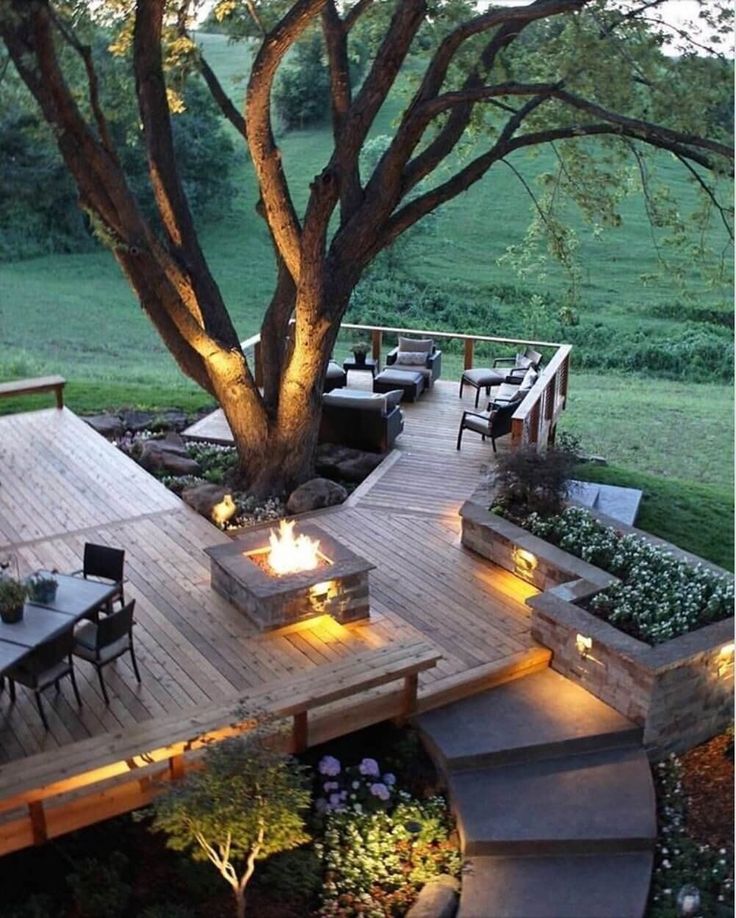 This is a great opportunity to create a dedicated planting area behind and along the retaining wall, while reclaiming a portion of your yard for an expanse of grass on level ground.
This is a great opportunity to create a dedicated planting area behind and along the retaining wall, while reclaiming a portion of your yard for an expanse of grass on level ground.
Related: Edge Your Beds: 11 Easy Ideas for Landscape Borders
istockphoto.com
Cultivate a Rock Garden
7/11
Hillsides can pose a landscaping challenge for plants, which can suffer from the soil erosion or poor drainage typical of sloping properties. When you arrange rocks of varying shapes and sizes on your hillside, you create a stable base for rock-loving plants like stonecrop, ornamental grasses, and creeping ground covers. A rock garden looks lush and satisfying to the eye, and reduces your maintenance load in the yard.
Related: 25 Plants for Your Easiest Garden Ever
istockphoto.com
Devise a Destination Fire Pit
8/11
Building hardscapes into a sloping property is a common and rewarding landscaping practice.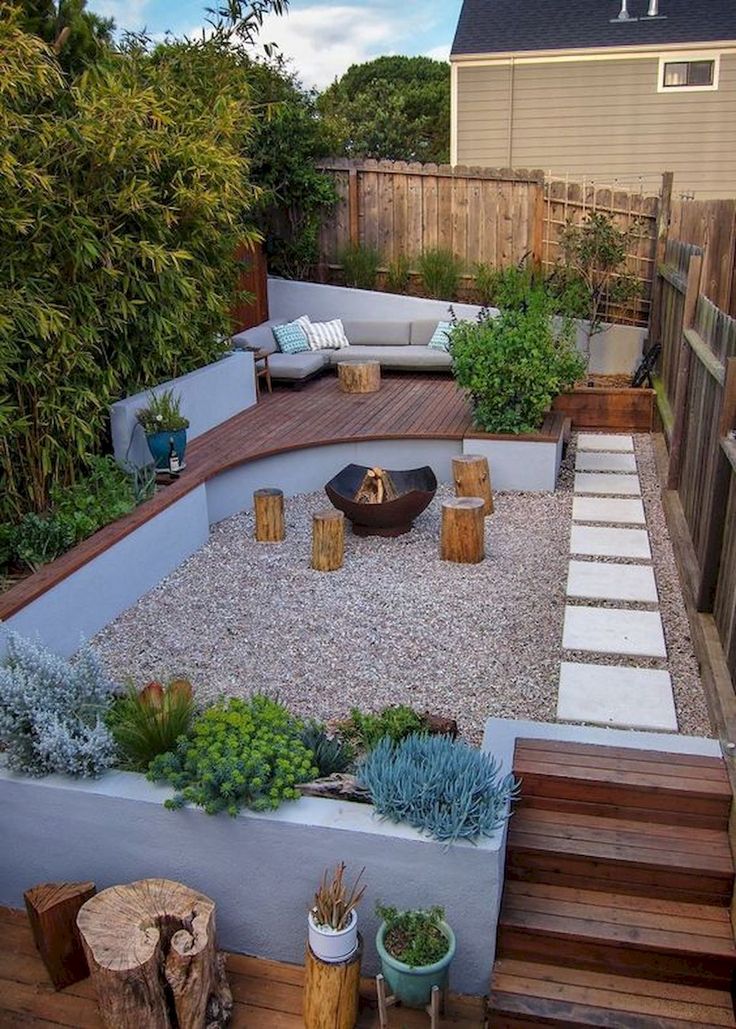 When a design culminates in an alluring destination like a fire pit, you’ll draw visitors through your yard and transform what might otherwise be neglected space into the place to be.
When a design culminates in an alluring destination like a fire pit, you’ll draw visitors through your yard and transform what might otherwise be neglected space into the place to be.
Related: No Money to Burn? 9 Fire Pits You Can Afford
istockphoto.com
Install Veggie Beds
9/11
You can take advantage of unused real estate on a slope that gets full sun by installing raised beds for vegetables. Deeper sections of the beds can be used for root vegetables that require more soil, and the shallower portions will be perfect for herbs and vining plants.
Related: 13 Creative Designs for Easy DIY Planters
istockphoto.com
Rely on Native Plants
10/11
Festooning a hillside with plants that are native to your area can help make maintenance easier in a spot that would be difficult to mow and landscape. With native plants, you can be fairly certain that they’ll be successful without much help from you, and they will help reduce erosion by providing a network of roots to hold soil in place.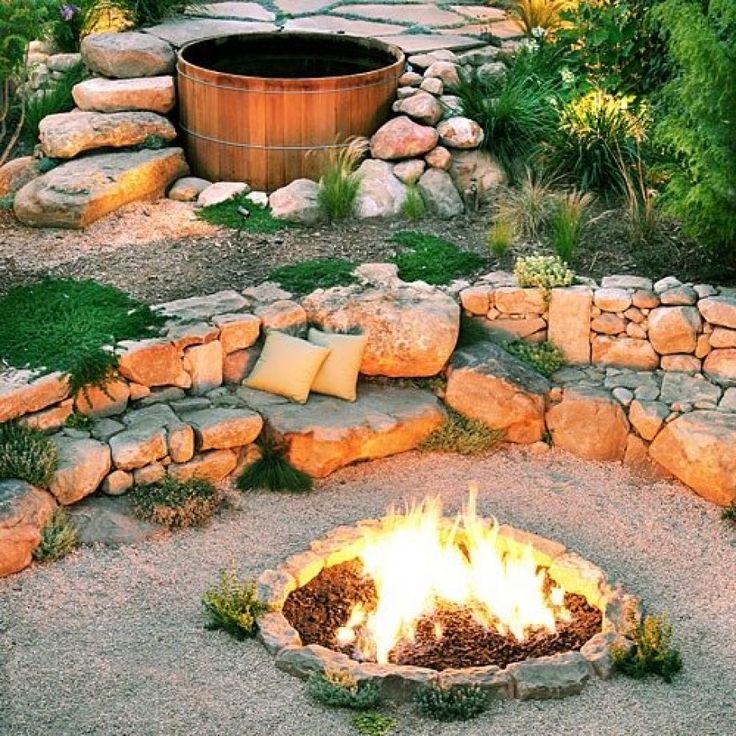
Related: 25 Amazing Plants That Are Native to North America
istockphoto.com
How to Cope with a Slope
11/11
With the right plan, even a steeply sloped backyard can be useable and enjoyable.
bobvila.com
Don't Miss!
If you have the money to hire a handyman for every household woe, go ahead. But if you want to hang on to your cash and exercise some self-sufficiency, check out these clever products that solve a million and one little problems around the house. Go now!
methods and options for arranging sloping plots
There is an opinion that a summer cottage located on a slope is not the best option for buying, but such territories have their own advantages. Among landscape design specialists there are many who are happy to take on the decoration and design of non-standard estates.
An important plus of an uneven area is that when it is designed, you can implement a lot of interesting ideas, combine the incongruous, transform flaws into aesthetics and benefit from them.
How to improve a site on a small and steep slope? Consider the basic principles, photos of finished landscape improvement projects for personal plots.
In order to implement some ideas in the flat areas for the improvement of the territory, hills are erected, bulk structures are formed, the relief is artificially transformed in order to create rises and slopes. And the estate, located on the slope, is a ready-made basis, which remains only to be formalized.
The main disadvantage, typical for the arrangement of territories on a slope, is high costs and laboriousness of work. This cannot be avoided, since for the improvement and creation of a garden zone and a vegetable garden, the construction of supports, fortification structures, terraces and steps is required.
The design of the site, the placement of buildings and functional areas may be different. The design features are affected by the degree of slope, the side of the site location (north, south).
The most unfortunate option is estates located on the northern slopes. The territory is isolated from the sun, remains in the shade almost all day - this becomes a limitation for the choice of plants.
The slopes to the south are great for creating vineyards, orchards and orchards. Retaining terraces on the slopes are the most successful place for setting up a vegetable garden. Vegetable crops planted in sunny areas grow quickly, and fruit seedlings produce a good harvest.
The plot may be partly located on a slope. The territory, part of which is on the plain, and part - on a slope, is easier to equip: a residential building and outbuildings are erected on a flat area, and the design of the slope is left for the future - for laying a garden and arranging beds and a vegetable garden as a whole.
We offer you to consider the best ways to use rockeries in landscape design: photos and examples of luxurious compositions in the garden and in the country, features of the structure.
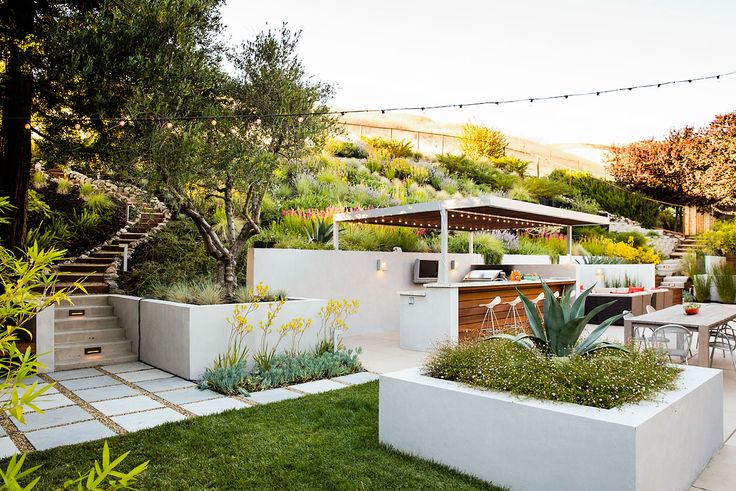
Ideas for building children's houses in the country with photos and examples can be found in this article.
Principles of zoning
When designing a manor on a slope and dividing it into zones, one should proceed from the individual wishes and possibilities that the site provides. Whatever option you choose to demarcate the territory, you need to follow certain rules.
- Residential building and utility buildings are located in the upper part of the slope. This placement is the most popular, it avoids flooding of buildings with precipitation and sewage, a drainage system is designed to drain them.
Near a residential building at a height, trees are planted that reach great heights: coniferous species, nuts, maples. Shrub varieties are planted along the perimeter of the slope, flower beds are created. Undersized ornamental plants are placed below, combining evergreen elements with seasonal ones. This approach allows you to create a picture that will please the eye at any time of the year.
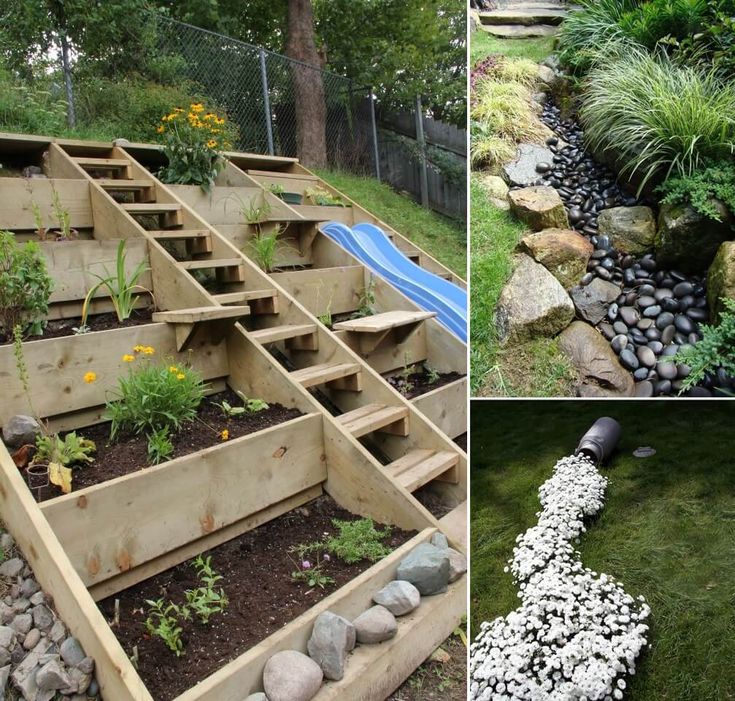
- House in the lower part of the estate. If the layout of the site is such that the stairs lead to a residential building located below, then the principle of placing green spaces will be slightly different. The cottage should be surrounded by small trees and shrubs, and undersized plants should be placed in the foreground. When developing a dendrological sketch of the territory, tall trees and a garden area must be placed in the upper sector of the estate, next to the entrance.
In this video you will learn how to decorate an area located on a slope:
Strengthening and decoration
Consider how and with what you can strengthen the slope on the site. The main disadvantages of the "convex" estate are the shedding of soil and washing it out with underground and melt water. In order for the site not to lose its attractive appearance over the years, work should be done to strengthen it.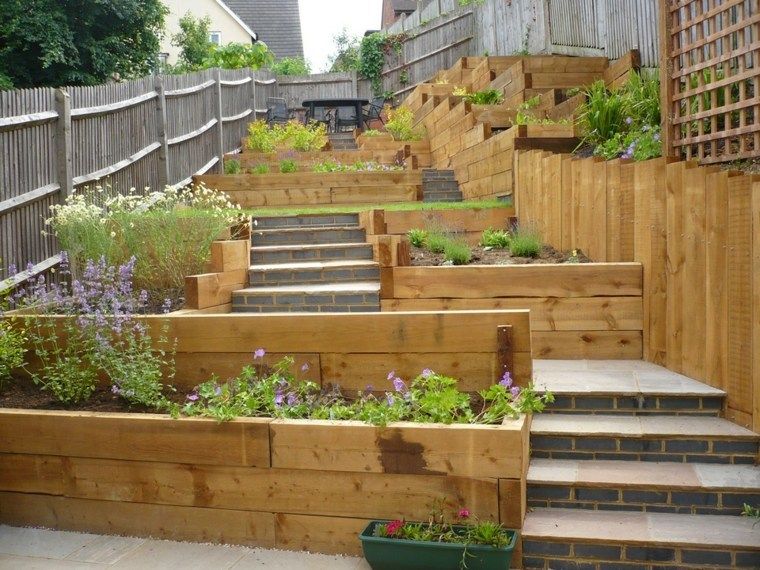 Thanks to homemade cascading structures, the arrangement of retaining walls, you can create an original landscaped area of \u200b\u200bthe house located on a slope.
Thanks to homemade cascading structures, the arrangement of retaining walls, you can create an original landscaped area of \u200b\u200bthe house located on a slope.
Tip: it is recommended to place shrubs and low-growing trees with a branched root system on the slope: increasing in volume, they will not only decorate the site, but also help to strengthen the slope.
The following plants can be used in planning to transform a neglected slope into an attractive corner:
- dogwood;
- miniature Christmas trees;
- barberry;
- juniper bushes;
- euonymus.
Note! Some types of shrubs - for example, wild rose - can perform not only a decorative purpose, but also be used for therapeutic purposes. A healing tea drink is prepared from rose hips.
But the main task of such plantings, as well as retaining walls and gabions, is to prevent soil shedding on the slope and retain moisture on the site.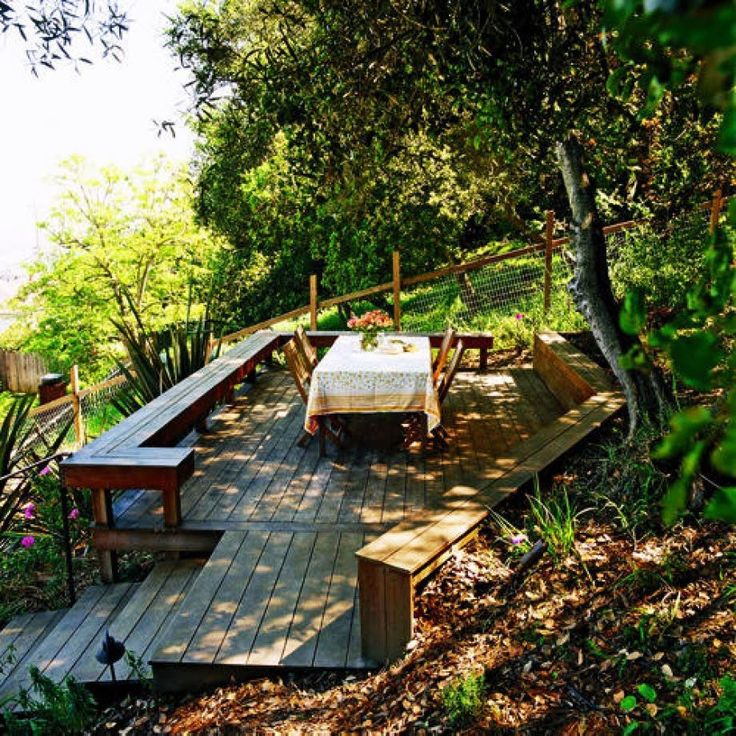 Retaining structures are engineering structures designed to strengthen the soil, contain earth masses. Landscaping of hills without retaining walls is almost impossible to perform, adding soil and strengthening the slopes will become a constant headache, and this problem will have to be constantly solved.
Retaining structures are engineering structures designed to strengthen the soil, contain earth masses. Landscaping of hills without retaining walls is almost impossible to perform, adding soil and strengthening the slopes will become a constant headache, and this problem will have to be constantly solved.
The photo below shows an approximate scheme for planning and zoning a site on a slope:
Based on the quality of the soil to be strengthened, supports can be divided into light and solid ones. Solid retaining structures, they are also called capital, can reach a height of three meters and need to be poured on the slope. Such supports are intended for long-term retention and consolidation of a heavy mass of earth. Before proceeding with the construction of such a wall, detailed engineering calculations should be performed.
Light retaining structures are designed without a strong foundation and are intended to a greater extent for decorating, strengthening a modest estate.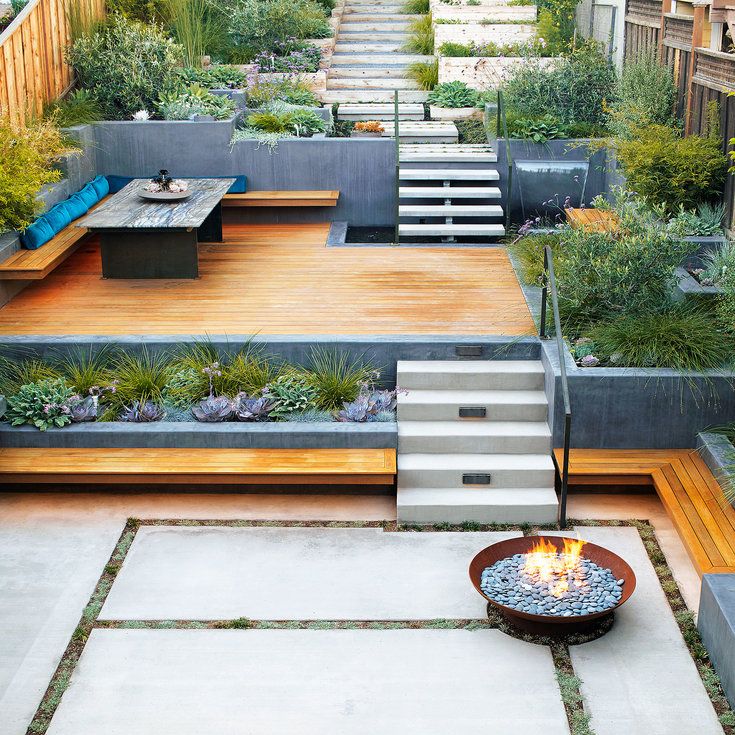
The following materials are used to create retaining structures:
- Wood . A wonderful decorative element, ideal for rural, Dutch and European landscapes. The disadvantage of such structures is their fragility. Wooden supports are preferably used when decorating low terraces, after carefully processing the wooden parts.
- Brickwork to emphasize the laconic lines in the design of the Art Nouveau landscape.
- Concrete blocks , which make it possible to build reliable supports with a long service life, can be made by hand and at no great material cost. Insufficiently presentable appearance of concrete structures can be changed by tiling or lining the fence with artificial stone.
- Real stone . The stone retaining structure turns out to be as reliable and durable as possible, but it is also expensive. Its front side fits perfectly into the design of the slope.
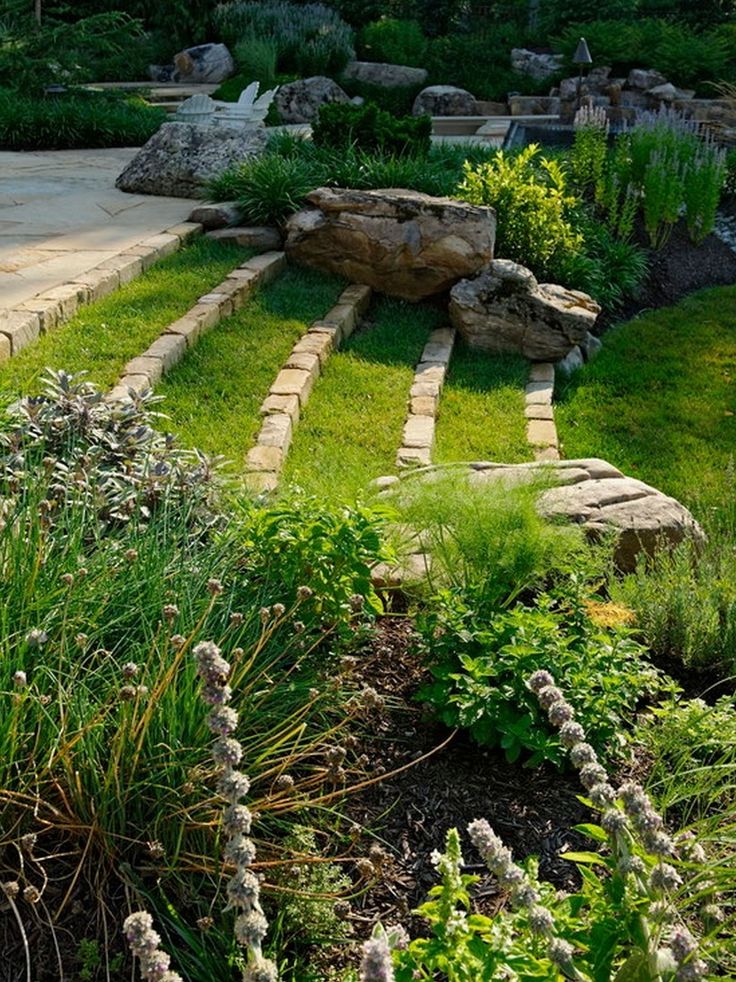
Soaring gardens and a panorama of the natural landscape
Supports, designed according to a certain plan, form an interesting picture with terraces. Leveling and terracing small areas on a steep hill makes it possible to obtain zones with soil for breaking up a vegetable garden, flower beds and a garden. With the help of autonomous terraces, areas intended for recreation are advantageously isolated.
Platforms with steps can be arranged in series or in a checkerboard pattern, the main thing is to follow one rule: the greater the angle of inclination, the narrower the terrace should be.
Competently executed strengthening of an uneven territory due to terraces allows solving a set of tasks:
- divide the site into zones;
- to strengthen the slope and create conditions for the diversion of water;
- facilitate freedom of movement by supplementing the terrace with stairs with steps of different or equal heights.
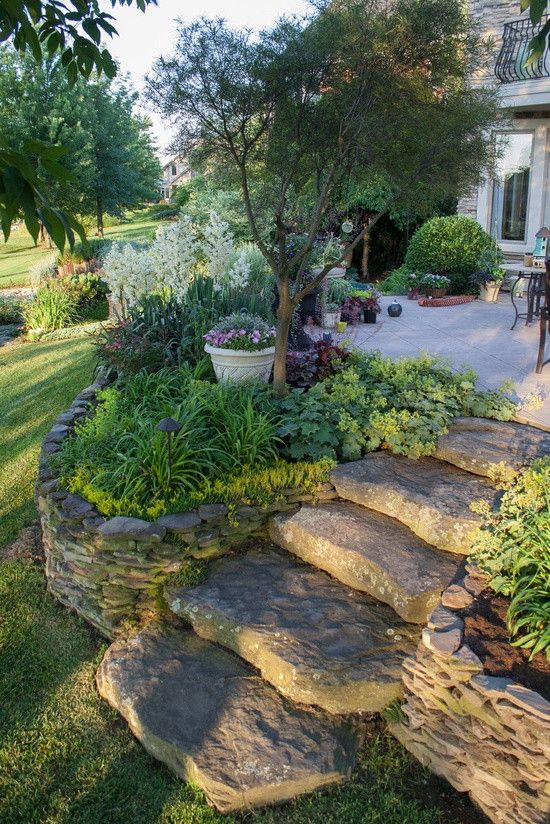
The original options for forming a recreation area on terraced areas confirm that they can be located at different levels. If you want to get a viewing platform, use the upper terrace for this purpose. You will get the opportunity to contemplate the picturesque landscape while drinking tea at the table.
Planning a place to relax on the lower terrace, on the other hand, will create a secluded environment protected from prying eyes and wind.
Steps and ladders
The plan of the estate on a hill in a vertical plane cannot be imagined without stairs and well-maintained garden paths. The main staircase, designed to move up and down, can be part of the terraces or be laid out of stone on a hill separately.
Attention! It is important that the steps are easy to move and harmonize with the design of the site.
Complementing the overall picture of landscape design, paths are created with steps or made out of serpentine. If the slope is high, it is worth making transitions with benches installed on them for rest. Landings, railings and paths are decorated with climbing plants.
If the slope is high, it is worth making transitions with benches installed on them for rest. Landings, railings and paths are decorated with climbing plants.
Stairs can be made of brick, wood, stone or concrete, but they must match the design of a private house, be comfortable and safe to use.
From this video you will learn about the role of retaining walls in the design and landscape decoration of a land plot with a slope:
Garden area and vegetable garden
Summer cottage is purchased primarily for growing vegetables and flowers. Despite the rather big expenses for strengthening and arranging terraces, a garden and a vegetable garden located on a hill have their own merits.
Hilly areas are better lit than flat areas, especially on the south side - this is one of the keys to a great harvest.
In the spring, the soil on the upper areas of the hill warms up more quickly, thereby extending the life of the garden areas.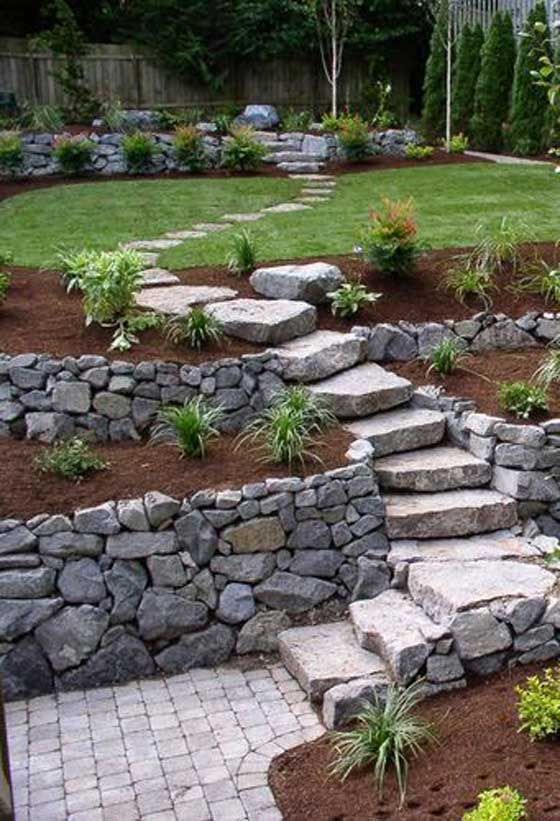 The first frosts affect the upper terraces later than others.
The first frosts affect the upper terraces later than others.
The division into functional zones and different planting heights make it possible to place plants that love heat and sun on the upper levels, and those that are resistant to cold - below.
With the right information and engineering skills, you will be able to competently arrange drainage and provide irrigation and rainwater without using additional water resources.
Terraced areas make it possible to alternate beds, stone gardens, flower beds and rock gardens.
The upper part of the hill is ideal for growing vines, planting apple and peach trees. On the beds you can plant onions, bell peppers and tomatoes. The middle part is optimal for shrubs, raspberries and flower beds. Below it is better to plant plants that are resistant to cold.
Plantations at the top and in the middle of the slope are most vulnerable to wind. When erecting buildings and choosing the type of fence, you need to take this moment into account and arrange them in such a way as to level this negative factor.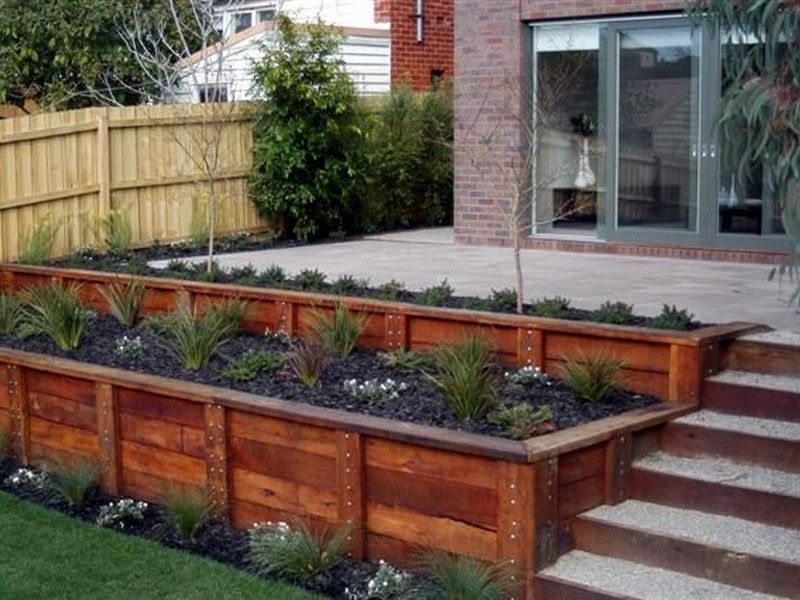
Water sources
Owners of suburban areas, who have decided to create an original landscape design on their estate, almost always equip miniature ponds and other water sources. The murmur of water attracts attention and helps to create a relaxing atmosphere that allows you to feel complete unity with the natural world.
Creating a stream with a waterfall on a flat area involves a large list of works. The advantage of the estate with a slope lies in the problem-free formation of several small reservoirs and waterfalls at once.
In most cases, cottages located on hills have a non-standard ravine in the lower zone, like a lake and even a swamp. Such imperfections in the landscape can be transformed into an unusual place to relax by designing a bridge and a wooden gazebo. Simply expand an existing pond and reinforce its sides with boulders, plant plants to decorate and enhance the slopes, and a beautiful pond will be ready.
Read about popular methods of making gabion retaining walls and options for using such structures in landscaping.
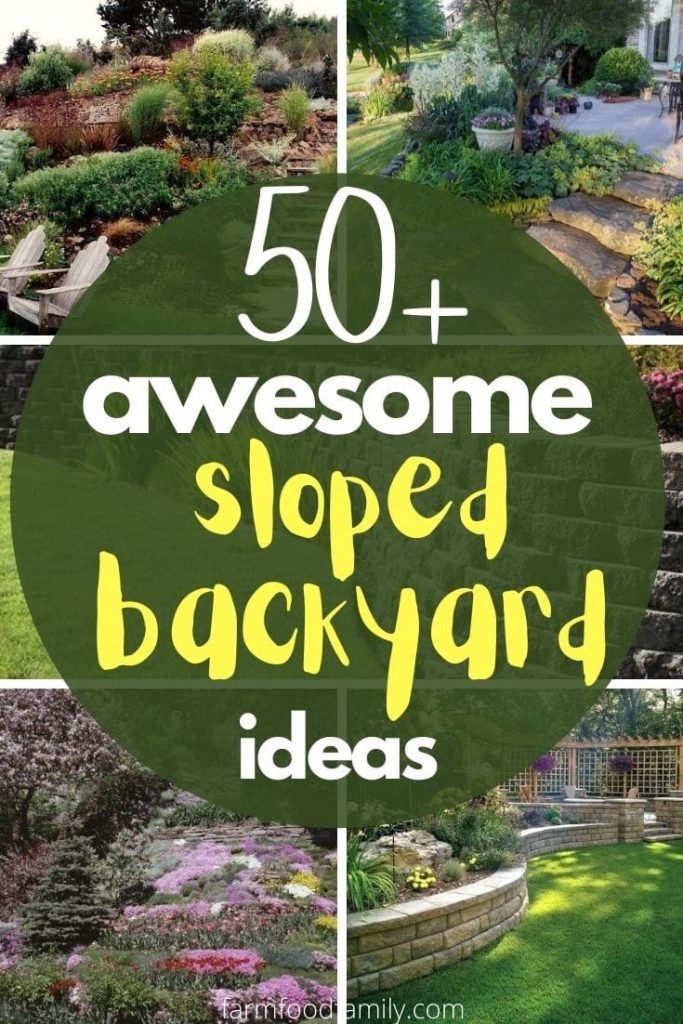
Which garden cement figurines can be made by hand? See examples and photos here.
Options for using a geogrid for a lawn are described in the article at: https://izbasv.com/exterer/georeshetka-dlya-dorozhek.html
Another interesting project will be the presence of a waterfall. Pipes for water drainage should be brought out so as to obtain an imitation of a natural stream with a waterfall. To create it on a steep hill, you will need a large number of stones of different sizes. Boulders are arranged so that different levels of heights are formed; the exit point of the pipe is covered with stones.
A pump will have to be installed to keep the pipes filled with water. The place of accumulation of water is transformed into a small reservoir if there is no access to the natural on the estate. Near the shore, a pond can be decorated with ornamental plants that love moisture, small meadow flowers and miniature garden figurines.
If desired, even a non-standard, seemingly impractical area can be turned into an attractive, originally designed corner.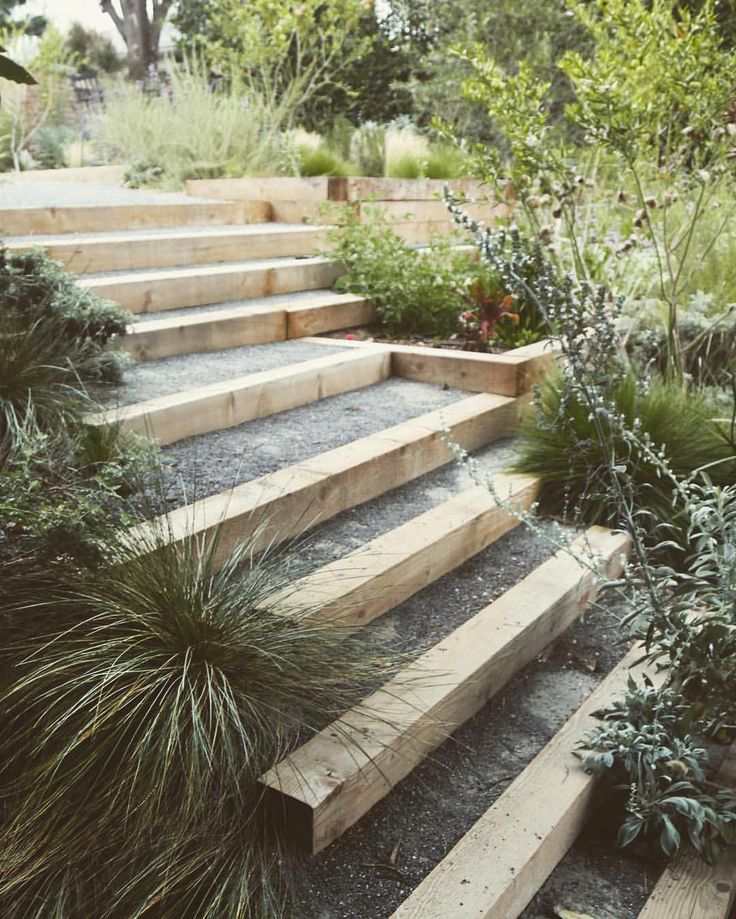
Photo gallery of finished projects
How to arrange a slope on the site? Look at other interesting ideas for decorating slopes on a country house plot, with different zoning methods - bright home improvement projects and a house plot with a slope:
If you have a plot with a slope, then you are here - ideas, photos, tips decided to share his experience and write an article on this overly important topic with slopes and drops, saturated with examples of sites with slopes, various drops, depressions and bumps, and
with what ideas, the designer modifies this relief beyond recognition , but as soon as I opened the word, the topic always turned up easier and my lazy brain instantly clung to it like a saving straw :).Well, there is nowhere to go, very rarely in our relief areas with a slope in Minsk and the Minsk region you can do without design, ideas, retaining walls, stairs, terracing and so on. So, let's figure it out together!
Basically, in such articles they write how cool and beautiful it is, then they add that you are very lucky, because you have a plot with drops, create, everything is in your hands.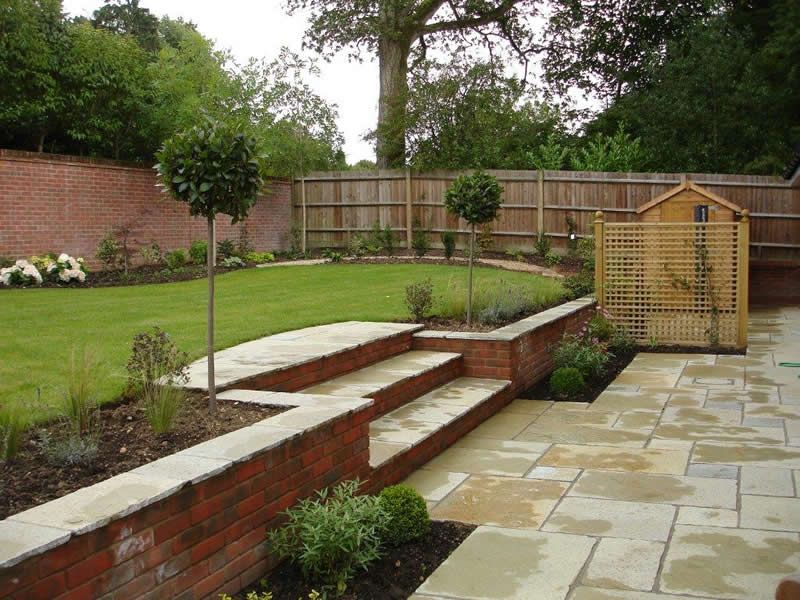 All these parting words are abundantly “fertilized” with a huge number of ideas and a bunch of beautiful photographs from all over the world, and at the end of the article, some masochists definitely recommend smearing stones with kefir to root moss in retaining walls. But it doesn't make it any easier for us, really :)
All these parting words are abundantly “fertilized” with a huge number of ideas and a bunch of beautiful photographs from all over the world, and at the end of the article, some masochists definitely recommend smearing stones with kefir to root moss in retaining walls. But it doesn't make it any easier for us, really :)
Since I like to fundamentally understand everything where the words design and landscape are, this article was no exception. My main task will be it’s not easy to go over ideas that are more misleading than helpful , but rather an analysis of real practical experience that sets you up to understand and feel the characteristic and technical techniques that can help you solve planning issues related to your relief area, where a retaining wall or stairs is just a means of how and other amenities.
So be patient and let's deal with this difficult relief topic.
Pay attention in this context, the aesthetics of the stairs is very important, but I will not touch on this important issue within the framework of this material, since Dima has already tried and described everything in detail in this article - the stairs on the site.
First, let's find the beginning. Pay attention to this drawing, it clearly demonstrates the possibilities and consequences of the same relief. Which do you like?
What do we feel when we build a house and equip a plot, seeing obvious relief differences? Surely we assure ourselves to think about it later during landscaping work. But after each rain, washed away soil and exposed small ravines remind of the inevitable.
Approximately the same feelings of anxiety are transmitted to me when I am engaged in the construction and improvement of these relief areas in Minsk and the Minsk region. And at the first meetings with customers, a clear emphasis and hope can be felt in the conversation. - "What do you think Dima, it is necessary to make retaining walls or you can do without them." You can easily, I answer, in your case, bring 60 cars of earth and fill up the lower part of the site right up to the roof of the already built bathhouse :)
Where do these fears come from!? It's simple, all people are mostly visual, and in this case they perceive the volume of their site statically and visually.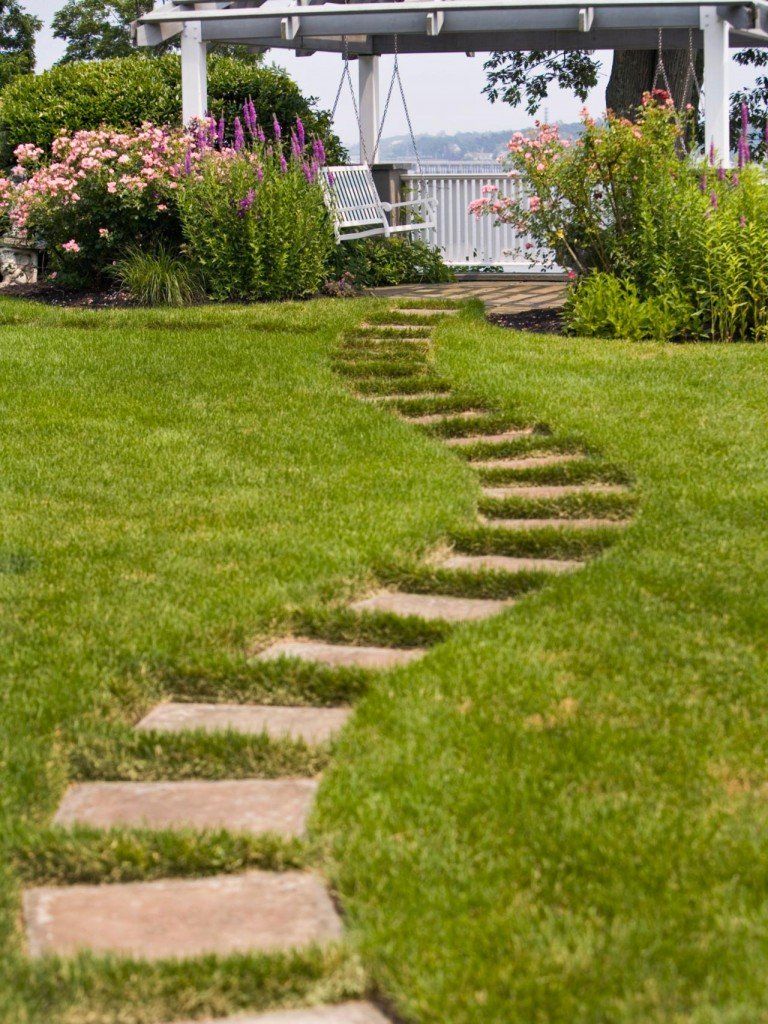 Therefore, when we have a flat area, we perceive it expressively and whole, we easily navigate in further actions. Another thing is when our site has a clear slope and relief changes, which raises many questions: where to place a retaining wall, what to build, hire people or do it yourself, how to link everything into one whole, what and where should the stairs be, whether drainage and so on.
Therefore, when we have a flat area, we perceive it expressively and whole, we easily navigate in further actions. Another thing is when our site has a clear slope and relief changes, which raises many questions: where to place a retaining wall, what to build, hire people or do it yourself, how to link everything into one whole, what and where should the stairs be, whether drainage and so on.
All of these factors prevent us from clearly seeing our site as a whole. And we, at the subconscious level, want to align everything and evenly divide it into terraces.
Have you ever wondered why there are so many TO-18 loaders in Minsk!? provide site planning services.
Machinists, who plan our sections, say - “so, now I’ll plan exactly here and trim it, don’t be afraid, the owner will be like a runway.” And imagine if they thoughtfully approached the change in the relief, suggesting what to preserve and what to strengthen, our sites would noticeably change.
Dima-Dima again idealistic nonsense, tractor drivers thinking about harmony and compositional integrity in landscape design, they don't even know such words.
Hence the main consequences in the form of a banal layout and a heap of ill-conceived monumental structures on the site with which one has to live in the future. How to avoid this?
- First, stop perceiving the elements (stairs, retaining walls, slopes) of terrain change as an existing problem in the form of self-sufficient volumes. It is necessary to perceive them as a logical, natural continuation of the relief of the site, where they are not dominant, but subordinate elements of one general idea. Here, without a hundred grams, ugh, you can't do without a plan!
Work out in detail on the master plan the possible options, thereby you will force your consciousness to perceive the area with the drops as a whole. Remember the plan provides an excellent opportunity for to see the interaction of all the fragmented elements and details, which is difficult to see in reality on the site.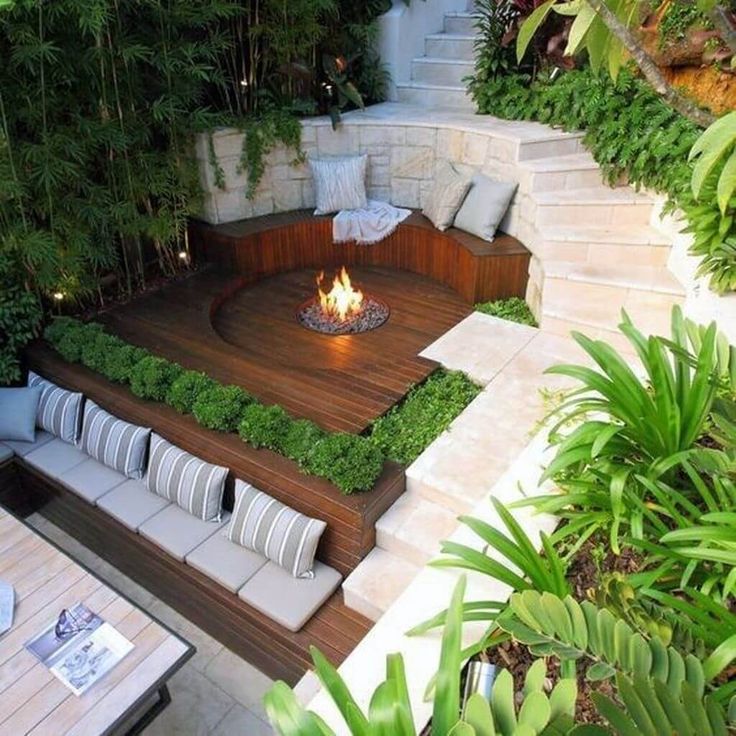 Each of you has his own manifestation of the relief, someone is in a lowland, someone has a tangible difference along the border line between neighbors, someone thinks where to put a house on a slope, and so on ad infinitum.
Each of you has his own manifestation of the relief, someone is in a lowland, someone has a tangible difference along the border line between neighbors, someone thinks where to put a house on a slope, and so on ad infinitum.
It is the hand-drawn plan that becomes a tangible breakthrough in the understanding of the site. Your, as it seemed to you, problematic topographic feature, now you can embrace it completely before your eyes, print 10 copies, edit over it with a marker, offer different options until you feel an interesting development of the scenario.
Further, working with the plan, you must constantly ask yourself the question, how else can I beat this drop?
- And here to start It is important to indicate where the household is located? If in your case the landscape is the dominant factor and you have chosen the site because of its views and the beauty of the surrounding landscape.
Then our goal is to further develop this theme and enhance the perception of nature.
Make it the main goal and the general theme of your site. So at this stage it is important to know the circulation of traffic on the site (I hope you have already drawn a plan where the paths, bathhouse and other volumes will be!), set priorities - highlight the main movement, that is, from parking to the house, from the house to the bathhouse and secondary paths for walking around the garden, what is this for ?!
Look, many of the relief areas where I was engaged in construction and landscaping in Minsk had already filled “supports” in the entire width of the area from fence to fence. Moreover, the main movement to the lower part occurred only through one-twentieth of the retaining wall where there was a staircase, and for the rest of the length the tiled retaining wall with a parapet was an alien element and destroyed the usable space?
Don't you think that it is much cheaper, more logical, and most importantly more organic to arrange a fragmentary retaining wall and stairs, and beat the rest of the drop using geoplastics and slope terracing.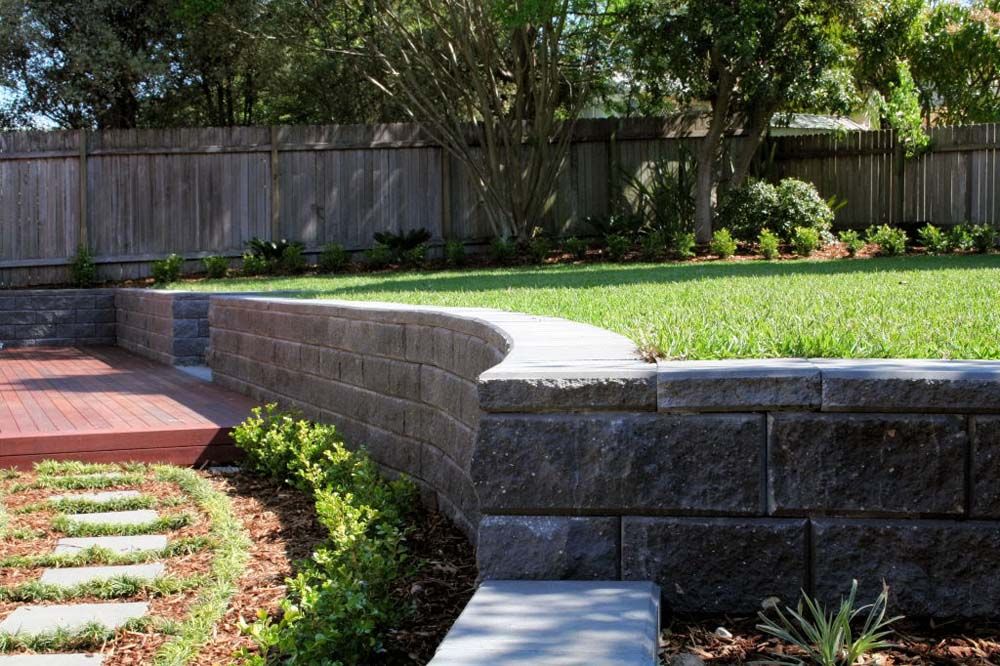
In this context, we are reinforcing our main goal to make the site feel as natural and organic as possible .
These slopes are subsequently ideal for creating a rock garden and lend themselves very well to landscaping with lawns and various crops that strengthen the upper horizon. In which you can design step-by-step stairs made of natural stone, arrange interesting patios, plant trees and shrubs, in other words, use them for their intended purpose.
The story on this topic, until I forgot. One early morning a man called me and asked me to urgently come to his site in order to solve the drainage problem, which was not related to landscape design. Arriving at the site in Tarasovo, I began to conduct hydrological surveys, and at that time he lamented for a very long time over the fact that he had chosen this site for building a house in the Minsk region. And now on its site with a strong slope at the very bottom there is always water and interferes with the construction work of the bath complex.
The granulometric composition of the soil of this area is loam, and besides, with a high COG. The customer insisted on carrying out drainage work. His house was being built for sale, and this wet moment confused potential customers. I offered him to turn the disadvantage into a distinctive feature. Namely, let a stream with a waterfall go down the slope and arrange a lake with fragrant water lilies near the bathhouse from below, attach a terrace on pillars to it.
Stormwater collected from the house is also to be dumped into this lake. On the spot, on the “knee”, I sketched out the concept and design of his site with a slope for him. At first, he was distrustful of this idea and probably thought “what kind of idiot this Dima is and who entrusted him with the level,” but then he apparently realized that for the same money for reclamation that he would dig into the ground, you can get elements that enrich the artistic site value. Accordingly, its liquidity in the real estate market will increase.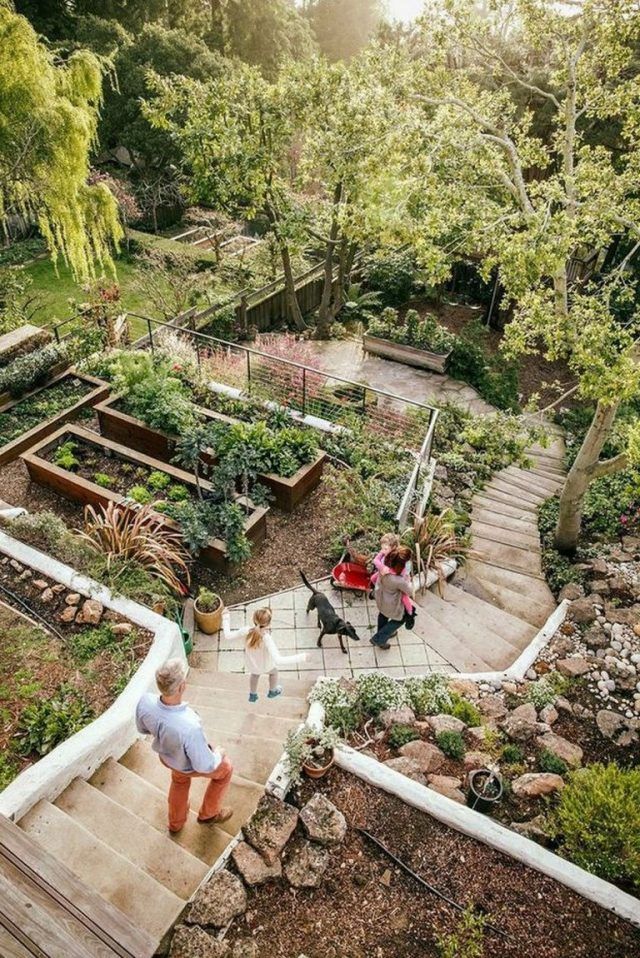 Subsequently, he applied for a project on this topic.
Subsequently, he applied for a project on this topic.
Remember, when you develop logical and characteristic themes on the site, then it will a priori look natural and beautiful.
Moreover, by manipulating the terrain, you enrich the variety of views from different vantage points. Make perspectives on other volumes of your garden semi-hidden and fascinating, gradually opening up.
Here is an example of the characteristic development of geoplastics. A customer contacted me with a request to find ideas for a site with a slope, and subsequently for pouring retaining walls, arranging a rolled lawn. His house was located behind Zaslavl among beautiful views of the hills, meadows and forests (this relief area in the region of Zaslavl and Logoysk in Belarus is commonly called Belarusian Switzerland) Moreover, he has no neighbors from all sides (lucky man). The house was built in the half-timbered style and lined with earth on all sides, and on three sides it is surrounded by terraces for admiring the Belarusian landscapes.
Having admired all this beauty, I didn't even think to fill in the retaining walls. I already intuitively knew what to do and was completely immersed in thoughts of how to technologically transfer the characteristic landscape motifs to the site of my client. As a result, the entire landscape around the house was designed in the form of green slopes with stones. In general, what is in the window is in the store.
- It is quite another matter if the plot is with a slope in the city or suburb of Minsk with a large number of neighbors .
In these conditions, our plots are limited geographically. We no longer have 25 acres, but usually 10 or 6 :( Every meter is important here. In this case, we need to work more carefully with the plan and think over the landscape design in detail.
And here we can safely state that we are part of society. In such dense urban, suburban and cottage areas, we feel like in an aquarium! dimension is the official entrance group in front of the house.
The second dimension is the area behind the house, and the third is the most sheltered, the most intimate for relaxation and reflection.Wind, noise, bustle is somewhere higher………
In this case, the sloping section is very good for us, since the descent is always identified with shelter and protection. And with proper zoning of the site, we can develop and enhance this feature of and eventually get a chamber patio, a small lawn or a gazebo by the pond, hidden from prying eyes, that is, our main requirement is to create isolation.Here is a good example.
Small plot on all sides densely populated by neighbors . I, while planning and designing a garden in Raubichi, Minsk region, isolated the most remote corner even more, and strengthened the feeling of intimacy by a general decrease. Moreover, he revealed and enhanced the characteristic natural features of the site with a slope, equipping from top to bottom a stream that flows into a pond under the terrace in the patio.The dimensions of this cozy patio repeat the dimensions of the terrace near the house. Everything is made from natural materials. Everything is focused on solitude and relaxation after a week of work.
- Important . In the city and the suburbs, natural materials - wood, stone, earth, plants, water - become even more important than in a distant village, where we are surrounded by all these textures in the literal sense. Therefore, make the most of natural materials to enhance your ecological island.
Let's look at a common planning error
Look, we can do it traditionally, just order the construction of a concrete retaining wall in Minsk, thoughtlessly pour it and we will get a lower terrace, or just 2 pencil cases crushing the most important area of the garden.It looks very disharmonious, but most importantly, these pencil cases subsequently determine the structure of landscape design.
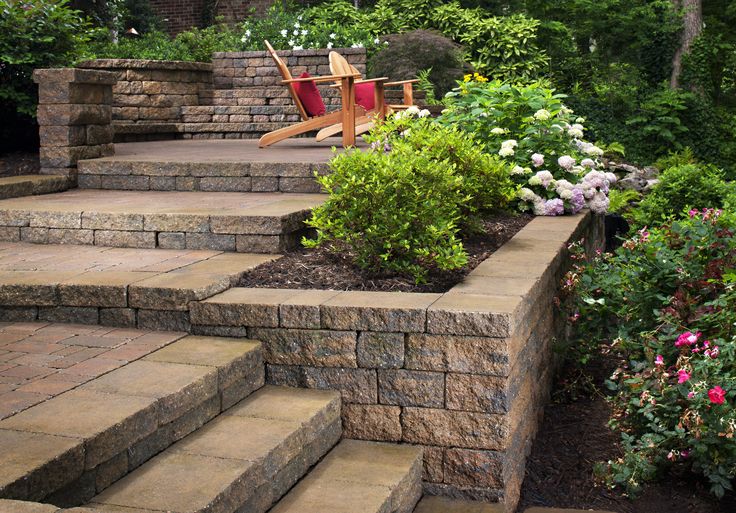
In this example, we organized a retaining wall in the most active traffic zone in the form of a closed courtyard near the bathhouse, and designed the second part, where there is much less traffic, in the form of a descending slope that can be formed in the form of a rock garden or other volume. Such an arrangement will strengthen the relationship with the house and the bathhouse, create a much more harmonious development of landscape design, and in the future your stay will be much more comfortable. It turns out and saved and strengthened.
Important. Use the golden section rule. If you choose to combine a retaining wall with a natural slope, stick to the one-third rule. That is, either the slope occupies 2/3, and 1/3 is a support with a ladder, or vice versa. Use the laws of similarity and identity. Use the dimensions of the house and materials for facade decoration in the dimensions of retaining walls, patios, terraces.
Let's say you have a house with a width of 11 meters. If this size is used in the dimensions of the retaining wall, patio, gazebos, then such a direct interaction unites disparate volumes. Your main task is to avoid fragmentation of unrelated elements.
Example “island” . I designed and built this zone in the form of a semicircle, which forms the lower island where there will be a gazebo and around the lake. Please note that on the side of the retaining wall there is a bridge for connecting two ponds, and the composition will be completed by a waterfall falling into the lake from the retaining wall.
This example shows a fragmentary retaining wall with stairs leading to the bath complex, I organized the rest of the area in the form of a natural slope.
Practice shows that many individual developers do not consider one of the best and more logical options for placing stairs, retaining walls and leveling the height difference on their site, on the side of the house, let's look at this option.
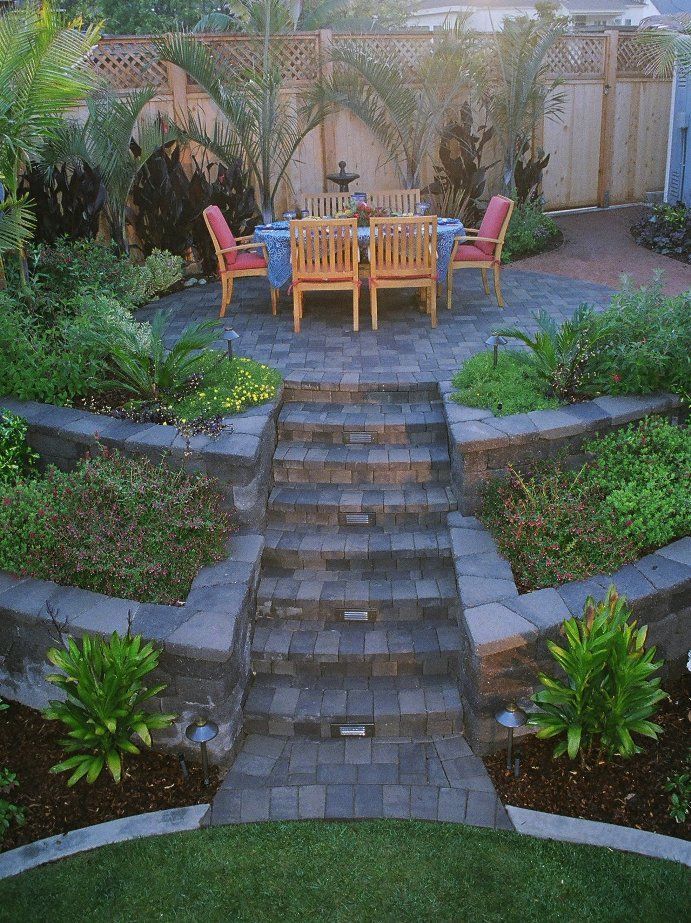
Each house has passages between the wall of the house and the fence on both sides, usually narrow.
These passages are ideal for the installation of stairs and retaining walls
1) With this arrangement, the stairs with the retaining wall will be located in narrow, little-used areas, as a result of which this gives us the opportunity to use the most important area behind the house without drops and heaps of concrete walls, for example, for family lawn.
2) There are many more options for technologically linking the landscape design with the design of the stairs, retaining wall or a group of stairs, terraces, as there are two verticals, a fence and a house wall. In which runs of stairs can rest. In addition, it is easy to use structures for vertical gardening.
And here is a clear example of a 1.5 meter difference, equipped on the sides of the house.
When designing the space of your site, always try to perceive retaining walls as an important element that must form some kind of isolated zone .
That is, retaining walls are always more harmonious when they predetermine or highlight the neighboring volume with their shape.
Being engaged in landscape design and construction of this site in the Minsk region, I attached double importance to all retaining walls. Please note that in addition to its direct task - holding the rock garden soil, it is part of the "yin-yang" zone, that is, a structural continuation of another zone. You may ask what came first, an egg or a chicken :) In this example, it doesn't matter, what matters is a well-thought-out drawn landscape design plan that allows you to work out the neighboring volumes in detail.
The next example on this topic. Pay attention to what faceless entrance groups we have and landscaping in front of cottages in the Minsk region. We just put the road board right under the line and that's it! In this context, I designed this group in the form of a low stone retaining wall giving the shape of a wave, which, firstly, fulfills its direct task - cuts off the roadway from the local area, and secondly, forms cozy lawns with plantings, clearly demonstrating that landscape design is here begins in front of the house and gradually intensifies throughout the entire relief area.

I repeat once again, the most important thing is not to make a common fatal mistake, do not divide the most important part of your back garden “stupidly” into fires, you can always find an interesting, and most importantly more organic development of the scenario. Moreover, imbued with the idea that the places of change of the slope of the relief must necessarily be emphasized or strengthened.
Just think, for the same money that we “swell” into concrete in Minsk, thereby deteriorating the artistic value of our suburban area, we can create, for example, a floating terrace, deck or gazebo towering over the slope of the site. The entrance to which we will densely plant with vines, leaving only a narrow passage.Entering it, we will see the views and perspectives that we design. Such a terrace or patio will become the main and favorite feature of your relatives and neighbors, as well as a distinctive feature of your relief area , because in this case, the structure in the form of a terrace on an inclined area equally belongs to heaven and earth, isn’t it wonderful?! Well, at least not trivial.
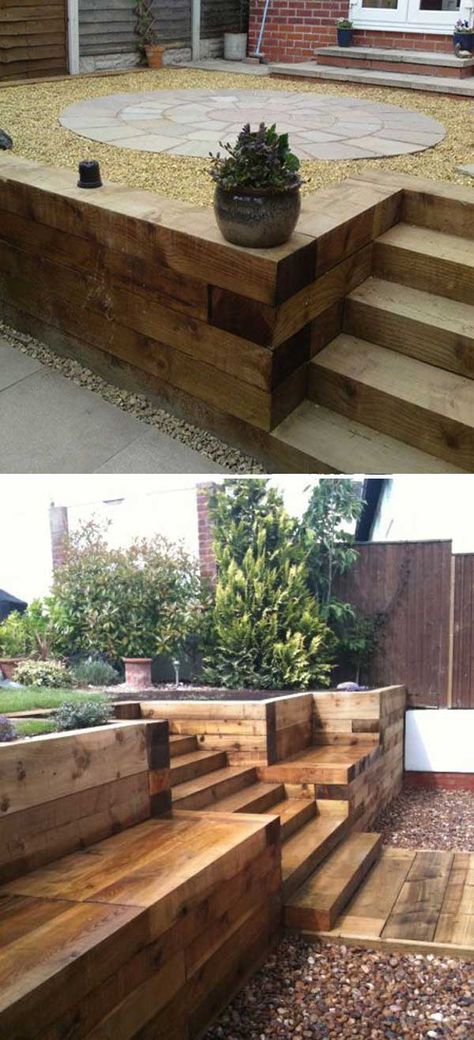
Learn more

